Big Time is in the process of on-chaining some core assets and is rooted in Web2 games. With sufficient development capabilities and operational experience, the game will have greater potential for development in the future.
Big Time is a large-scale multiplayer online role-playing game (MMORPG) built on Ethereum, with a leading team and financing in the industry. The game is currently in the internal testing phase and has basically formed the prototype of an MMORPG, as well as completed the conceptual construction of the game's sustainable economic mechanism. The game experience is good, has a certain degree of playability, and the blockchain gaming track still maintains a good scale in the current bear market. After the zero-threshold opening of Big Time in the future, it may attract more players to join.
Project Overview
Big Time is a large-scale multiplayer online role-playing game (MMORPG) built on Ethereum. The game is currently in the internal testing phase and has basically formed the prototype of an MMORPG, as well as completed the conceptual construction of the game's economic mechanism.
In terms of the team, the Big Time team has a solid background in the gaming and crypto fields, with core members having experience in developing large-scale games or working in large game companies. Compared to the first research report in May 2022, there have been some changes in the core team members of Big Time. The departure of the product director and the director of game economic model design may have had a certain impact on the development and delivery of the game, and subsequent work has been taken over by other experts deeply rooted in the gaming industry. Additionally, as Big Time Studios is a game studio that operates completely remotely worldwide, it will also have a certain impact on the timely delivery of the game.
In terms of funding, Big Time has raised over $90 million through primary market financing and NFT sales, which is enough to support the development of a AAA-level game. After the game goes live, the project team can continue to operate sustainably through the sale of in-game resources.
In terms of the core game mechanism, Big Time has basically drawn on the role and growth design of mature MMORPGs, but its free job change system will enrich the player's game experience. However, this also poses requirements for the balance adjustment of the game team, as the lower job change threshold means that if a certain profession's abilities are particularly outstanding, it will squeeze the survival space of other professions, thereby affecting the game's playability.
In terms of the game's economic mechanism, Big Time's design is very clever, ensuring that the in-game economy has a certain elasticity on a stable basis, and also ensuring that both free and paying players can have a rich game experience. However, this kind of economic mechanism also places high demands on players' strategies for allocating resources in the game.
In terms of actual game experience, the game already has a certain degree of playability, but it will require more iterations in the future to improve the game's visual performance and gameplay mechanisms.
In terms of the game's threshold, the game's hardware requirements do not seem to be high at the moment, but players need to meet certain requirements to participate in the preseason.
In terms of project development, the game's current operational and development pace is slower than expected, but the game has already attracted a group of highly sticky core players. After the zero-threshold opening of Big Time in the future, it may attract more players to join.
In terms of the track, since entering the bear market, although the number of players and trading volume in the blockchain gaming track has decreased to a certain extent, the core group of blockchain game players still maintains a high stickiness, and the overall development progress of the track has not been significantly affected. Many new games are still being developed and operated. Once the overall macro environment warms up, the blockchain gaming track still has room for imagination. Based on the different types and development stages of the blockchain gaming track, we believe that games like Big Time, which on-chain some core assets and are rooted in Web2 games, and have sufficient development capabilities and operational experience, will have greater development potential in the future.
1. Basic Overview
1.1 Project Introduction
Big Time is a large-scale multiplayer online role-playing game (MMORPG) built on Ethereum. The game is currently in the internal testing phase and has basically formed the prototype of an MMORPG, as well as completed the conceptual construction of the game's economic mechanism.
1.2 Basic Information

2. Project Details
2.1 Team
According to the official website [1], the current core team of Big Time consists of 38 members, and according to LinkedIn disclosure [2], the Big Time team currently has 89 employees, an increase of 22 staff from the initial 2022 report. From the beginning, Big Time recruited an all-star team of senior professionals from the gaming industry from top game companies such as Epic Games, Blizzard, EA, and Riot. The introduction and corresponding changes of core team members are as follows:

Ari Meilich, CEO, former co-founder and CEO of Decentraland, previously worked as a market research analyst at Charles River Ventures, a Silicon Valley venture capital fund, and founded the big data company Benchrise, serving as CEO, with rich experience in venture capital and data analysis.

Matt Tonks, CTO, served as the chief programmer of COR Project from 2004.01 to 2005.05; software engineer at Electronic Arts from 2005.05 to 2007.10; senior AI programmer at Epic Games from 2007.10 to 2012.7; technical director at Drifter Entertainment from 2016.01 to 2020.08; co-founder of BitMonster since 2012.03. Matt Tonks has been dedicated to the gaming industry for the past 18 years and has extensive game development experience.
 Thor Alexander, CPO, served as Development Director at Epic Games from 1999.04 to 2006.12; Founder and Editor at MMP Game Development from 2002.10 to 2005.02; Product Management Director at Metaplace, Inc. from 2006.12 to 2008.11; Executive Producer at Zynga from 2008.11 to 2011.12; Founder and CEO at Lucky Puppy, LLC from 2012.03 to 2017.08; Vice President of Product at Decentraland from 2018.11 to 2020.04. Thor Alexander is an OG in the traditional gaming industry, with over 25 years of experience in game production, having handled multiple successful game projects, and has extensive entrepreneurial experience. There is currently no information on the official website, and it is highly likely that he has left the company, with his work being taken over by Brian Chu.
Thor Alexander, CPO, served as Development Director at Epic Games from 1999.04 to 2006.12; Founder and Editor at MMP Game Development from 2002.10 to 2005.02; Product Management Director at Metaplace, Inc. from 2006.12 to 2008.11; Executive Producer at Zynga from 2008.11 to 2011.12; Founder and CEO at Lucky Puppy, LLC from 2012.03 to 2017.08; Vice President of Product at Decentraland from 2018.11 to 2020.04. Thor Alexander is an OG in the traditional gaming industry, with over 25 years of experience in game production, having handled multiple successful game projects, and has extensive entrepreneurial experience. There is currently no information on the official website, and it is highly likely that he has left the company, with his work being taken over by Brian Chu.
 Brian Chu, Product Management Director, entered the gaming industry in 2007 and became a Marketing Development Intern at Salesforce. In 2008, Brian joined Deloitte Consulting as a Senior Consultant, providing consulting services to multiple companies in the interactive entertainment, software, and mobile information industries. In 2009, Brian joined Zynga as the Chief Product Manager for the CityVille project. He then served as Vice President of Product at Identified in 2012. In 2013, Brian joined Blizzard Entertainment as the Global Brand Management Director, responsible for global brand marketing strategy, budget, and execution for "Heroes of the Storm" and "StarCraft II." In 2016, Brian served as the Product Director at Rocket Games, which was acquired by Penn Interactive Ventures in April 2017. In 2017, Brian served as the Product Management Director at EA, and later joined Epic Games in 2019 in the same position. In April 2022, Brian joined Big Time and has been serving as the Product Management Director since then.
Brian Chu, Product Management Director, entered the gaming industry in 2007 and became a Marketing Development Intern at Salesforce. In 2008, Brian joined Deloitte Consulting as a Senior Consultant, providing consulting services to multiple companies in the interactive entertainment, software, and mobile information industries. In 2009, Brian joined Zynga as the Chief Product Manager for the CityVille project. He then served as Vice President of Product at Identified in 2012. In 2013, Brian joined Blizzard Entertainment as the Global Brand Management Director, responsible for global brand marketing strategy, budget, and execution for "Heroes of the Storm" and "StarCraft II." In 2016, Brian served as the Product Director at Rocket Games, which was acquired by Penn Interactive Ventures in April 2017. In 2017, Brian served as the Product Management Director at EA, and later joined Epic Games in 2019 in the same position. In April 2022, Brian joined Big Time and has been serving as the Product Management Director since then.
Michael Migliero, CMO, served as a Product Marketing Assistant at Akamai Technologies from 2007 to 2008; Co-founder and CEO of Fractional Media (an advertising services company) from 2012.12 to 2018.05; DSP Director at Machine Zone (MZ) from 2015.05 to 2018.05.
 Ken Harsha, Chief Animator, Creative Director, has over 31 years of experience in specialized animation, television animation, and gaming. He has served as an art director, production designer, director, writer, story artist, storyboard artist, and visual development artist, and has a considerable reputation in the American entertainment industry. Ken Harsha has been involved in multiple projects at Disney, DreamWorks, and Warner Bros, provided art direction for multiple series of the Call of Duty games, and served as Art Director, Producer, Production Designer, and Film Director at Electronic Arts for over 5 years, managing the concept art department at Treyarch for over 8 years.
Ken Harsha, Chief Animator, Creative Director, has over 31 years of experience in specialized animation, television animation, and gaming. He has served as an art director, production designer, director, writer, story artist, storyboard artist, and visual development artist, and has a considerable reputation in the American entertainment industry. Ken Harsha has been involved in multiple projects at Disney, DreamWorks, and Warner Bros, provided art direction for multiple series of the Call of Duty games, and served as Art Director, Producer, Production Designer, and Film Director at Electronic Arts for over 5 years, managing the concept art department at Treyarch for over 8 years.
 Daniel Paez, Game Economic Model Design Director, served as a Product Manager at VisusTV and Industrial Engineer at IBM Brasil from 2009 to 2015, as well as a Business Development Manager at Gresso Miami. From 2015 to 2015.06, he served as an Apple SPO Specialist; from 2015.06 to 2020.12, he served as a Pricing Manager and Publishing Intelligence Manager at Blizzard Entertainment. From 2020.12 to 2021.08, he served as Senior Manager of Business Finance and Operations at Activision. In addition to working at Big Time, Daniel also serves as the Game Economic Model Design Director at Worldspark Studios. According to LinkedIn information, Daniel left the company in February 2022, and was succeeded by Khaled Alroumi as the Director of Game Monetization and Economics.
Daniel Paez, Game Economic Model Design Director, served as a Product Manager at VisusTV and Industrial Engineer at IBM Brasil from 2009 to 2015, as well as a Business Development Manager at Gresso Miami. From 2015 to 2015.06, he served as an Apple SPO Specialist; from 2015.06 to 2020.12, he served as a Pricing Manager and Publishing Intelligence Manager at Blizzard Entertainment. From 2020.12 to 2021.08, he served as Senior Manager of Business Finance and Operations at Activision. In addition to working at Big Time, Daniel also serves as the Game Economic Model Design Director at Worldspark Studios. According to LinkedIn information, Daniel left the company in February 2022, and was succeeded by Khaled Alroumi as the Director of Game Monetization and Economics.
 Khaled Alroumi, Director of Game Monetization and Economics, entered the gaming industry in 2010 and co-founded several gaming companies in Kuwait and Dubai, developing the game "War Front: Battle of Tolia." In 2021, Khaled Alroumi joined the blockchain game Illuvium as the Game Systems and Economic Designer. In September 2022, Khaled Alroumi joined Big Time and has been serving as the Director of Game Monetization and Economics since then.
Khaled Alroumi, Director of Game Monetization and Economics, entered the gaming industry in 2010 and co-founded several gaming companies in Kuwait and Dubai, developing the game "War Front: Battle of Tolia." In 2021, Khaled Alroumi joined the blockchain game Illuvium as the Game Systems and Economic Designer. In September 2022, Khaled Alroumi joined Big Time and has been serving as the Director of Game Monetization and Economics since then.
 Aaron Smith, Art Director, previously worked at Rogue Entertainment, Nerve Software, Epic Games, and is also a co-founder and game artist at Bitmonster, Inc. Aaron Smith is an artist with over 20 years of experience in the gaming industry, specializing in concept art, 3D character and environment modeling, and has over 17 years of experience with the Unreal Engine, making him a seasoned gaming industry professional.
Aaron Smith, Art Director, previously worked at Rogue Entertainment, Nerve Software, Epic Games, and is also a co-founder and game artist at Bitmonster, Inc. Aaron Smith is an artist with over 20 years of experience in the gaming industry, specializing in concept art, 3D character and environment modeling, and has over 17 years of experience with the Unreal Engine, making him a seasoned gaming industry professional.
 Martin Sweitzer, Chief Engineer, served as a software developer at Trilogy from 1998.06 to 2000.05; programmer at Sony Online Entertainment from 2000.11 to 2001.10; Founder of Sigil Games Online from 2002.01 to 2004.06; Senior Game Programmer at BrickHouse Games, Epic Games, and Squanch Games from 2004 to 2017, and is also a co-founder of Bitmonster, Inc. Martin Sweitzer is a seasoned gaming industry professional with over 20 years of game development experience.
Martin Sweitzer, Chief Engineer, served as a software developer at Trilogy from 1998.06 to 2000.05; programmer at Sony Online Entertainment from 2000.11 to 2001.10; Founder of Sigil Games Online from 2002.01 to 2004.06; Senior Game Programmer at BrickHouse Games, Epic Games, and Squanch Games from 2004 to 2017, and is also a co-founder of Bitmonster, Inc. Martin Sweitzer is a seasoned gaming industry professional with over 20 years of game development experience.
TJ Stamm, Chief Designer, began working in the gaming industry around 2000, previously holding designer positions at companies such as Electronic Arts and Infinity Ward, where he was responsible for production, design, and art for multiple games. During his 6-year tenure at Infinity Ward, he was primarily responsible for weapon design and in-game balance for the "Call of Duty: Modern Warfare" and "Infinite Warfare" series.

Cedric Fleury, Chief Designer, entered the gaming industry in 2006, working at Threewave, EA, and SE as a level designer for multiple games, including "Far Cry 4" at Ubisoft, where he was primarily responsible for the open-world environment design. Cedric Fleury also served as a senior level designer for projects at WB Games and EA. In May 2022, Cedric Fleury joined Big Time and has been serving as the Chief Designer.
Ari Meilich is the CEO of the Big Time project and is also the former co-founder and CEO of Decentraland. In addition, most team members have extensive experience in the traditional gaming industry and have worked at major companies. Based on the team's experience, they have professional game development experience and have been involved in the design and development of several top games, including "League of Legends," "Fortnite," "God of War," "Call of Duty," and "Overwatch." Compared to the first research report in May 2022, there have been few changes in the core team members of Big Time, but the departure of the Product Director and the Game Economic Model Design Director may have had a certain impact on the game's development and delivery, with subsequent work being taken over by other experts in the gaming industry. Additionally, as Big Time Studios is a fully remote game studio worldwide, this may also have a certain impact on game development.
2.2 Funding
2.2.1 Financing
On May 12, 2021, Big Time Studios announced the completion of a $21 million financing round, divided into two parts. The first part of $10.3 million was led by FBG Capital, with participation from North Island Ventures, Digital Currency Group, DFG, OKEx Blockdream Ventures, Alameda Research, LD Capital, YBB Foundation, Circle Financial, and Sound Ventures created by Ashton Kutcher. Additionally, Big Time Studio completed a $11 million financing round, which will be used to invest in game companies willing to use related NFT technology.
2.2.2 NFT Sales
In addition to financing, Big Time also generated significant revenue through multiple in-game NFT item sales activities, as detailed below:
1) First Sale on Binance NFT Marketplace
On July 22, 2021, Big Time launched its first NFT Drop on the Binance NFT marketplace, which sold out completely, with the total value of NFTs sold amounting to $667,160.
2) Binance NFT Marketplace Sale Part 2
On August 13, 2021, Big Time initiated the second round of sales on the Binance NFT marketplace, with the total value of NFTs sold amounting to approximately $2,905,200.
3) SPACE NFT Sales
On December 21, 2021, Big Time launched the sale of SPACE NFTs, with a total of 60,000 SPACE NFTs (10% of the total supply) being sold. The details of the sale are provided in the accompanying image.
Figure 2–1 SPACE NFT Sales Details [6]
Combining the two tables in Figure 2–1, we can calculate that Big Time sold a total of SPACE NFTs worth $38,148,000 in the first SPACE NFT sale.
4) Mystery Box Sales


Table 2–3 Mystery Box Market Sales (February 2022)
On February 17, 2022, Big Time launched the Mystery Box sales event on the Binance NFT marketplace. A total of 25,000 Mystery Boxes were sold, with each box priced at 25 BUSD, resulting in a total value of $625,000.
5) Exalted SPACE Special Sale

Table 2–4 Exalted SPACE NFT Market Sales
On March 24, 2022, Big Time conducted the Exalted SPACE NFT sales event, selling a total of 3,000 Exalted SPACE NFTs (0.5% of the total SPACE NFT supply) and 12,000 Mythic SPACE NFTs (2% of the total SPACE NFT supply). The sale prices for the NFTs varied, with the Mythic SPACE NFTs ranging from $36 to $691, and the Exalted SPACE NFTs ranging from $1,066 to $11,381.
6) Open Loot Mystery Box Holiday Special Sales (Christmas, Lunar New Year)

Table 2–5 Open Loot Mystery Box Holiday Special Sales (Christmas, Lunar New Year)
During the Christmas and Lunar New Year holiday special sales, Big Time sold 4,500 and 7,388 Mystery Boxes on Open Loot, respectively. The boxes contained three types of functional NFTs for use in SPACE: Armory, Furnace, and Time Guardian, with different drop rates and prices.
7) Game Guild Subscriptions
Currently, Big Time has partnered with over 20 game guilds, including YieldGuild, Merit Circle, Avocado Guild, Loudgg, Neo Tokyo, Black Pool, Polkastarter, YGG Sea, ReadyPlayerDAO, and 3D Gamers Guild DAO. Most of the guilds have purchased NFT assets within the Big Time game, but specific sales figures have not been disclosed.
In summary, conservatively estimating the revenue from multiple NFT sales events since its inception, Big Time has generated approximately $72,865,761 in revenue (not fully comprehensive, actual figures may be higher, as there have been claims within the community that Big Time has made over a billion dollars in profit from multiple NFT sales events, but this information has not been confirmed and is for reference only).
In addition to the previous $21 million in funding completed by the team, Big Time's treasury currently holds approximately $93.87 million. Even considering that Big Time is benchmarked against AAA games, which typically require development costs in the tens of millions or even hundreds of millions of dollars, Big Time's treasury can be considered quite sufficient at this stage, enough to support the project's development and operations for a considerable period in the early stages.
2.3 Code
Big Time is built on Ethereum and utilizes Procedurally Generated Goodness technology to expand off-chain scalability. The overall framework is similar to most blockchain games on the market, where game assets are on-chain, and the game runs on off-chain servers. The specific codebase has not been open-sourced.
2.4 Product
Big Time is a large-scale multiplayer online role-playing game (MMORPG) inspired by time travel.
Generally, as a subclass of RPG games, MMORPGs should first meet several core elements of RPG games:
1) Character Elements: Players will need to choose or play a certain character in the game, with specific abilities and attributes.
2) Interaction Elements: The game generally includes built-in combat systems, mission systems, NPC systems, map systems, loot systems, and other mechanisms that provide feedback based on player actions.
3) Growth Elements: Growth elements are generally crucial in RPG games. Common RPG game growth elements include internal and external growth mechanisms. Internal growth mechanisms, such as level and skill systems, allow players to improve their abilities through combat and exploration without relying on external resources. External growth mechanisms, such as equipment and items, are obtained through the accumulation of external resources like gold coins and contribute to the character's growth. A good RPG game will strive to balance internal and external growth mechanisms to provide players with a smooth gaming experience.
What sets MMORPGs apart from other types of RPG games is the different gaming experience.
For example, in terms of gaming experience, Japanese RPGs tend to focus more on guiding the main storyline, where players essentially play a role in a script set by the game developer. The game usually has a single ending, and even in the case of multiple endings, there are clear paths to achieve them. Differentiated player experiences are supplemented by side storylines, but overall, they do not deviate too much from the main storyline set by the game.
On the other hand, American RPGs, derived from Table RPGs (e.g., Dungeons & Dragons), tend to weaken the influence of the main storyline and introduce more random elements to emphasize the impact of player actions on the game. American RPGs provide players with more differentiated experiences through the accumulation of interactive elements, allowing players to form their own game memories. These games often feature multiple endings as feedback for player actions.
In concept, MMORPGs basically follow the design philosophy of American RPGs, emphasizing bidirectional interaction rather than unidirectional experience. They generally provide short introductory storylines to help players establish a basic worldview and may not even have the concept of a "conclusion," with the main gaming experience based on interaction with game elements. Additionally, MMORPGs emphasize player interaction and can be considered to some extent as a form of online social game.
In the following sections, we will first introduce the game's world setting and then provide a certain degree of analysis of the game's three core elements and gameplay mechanisms.
2.4.1 Big Time Game Story Background [10] [11] [12] [13]
Note: This section provides an introduction to the game's story background and is not the main focus. Readers not interested in this can skip directly.
Every MMORPG game has its unique game background and storyline, and Big Time is no exception. The story of Big Time is set in the future of the human world, where a mysterious force is threatening the balance of the universe. Time has been distorted, different eras are colliding with each other, and the entire spacetime of the universe has been severely disrupted. Survivors have fled to the last refuge in the universe, a place called Big Time's End.
However, due to the influx of survivors from different time and space, the small asteroid Big Time's End quickly became overwhelmed. At this time, a solution appeared (seemingly out of thin air, perhaps with the support of an unknown mysterious force). A person named Canard Cincade created the Paradox Corporate company and produced batches of small robots called Clockies to maintain the order of the spacetime world. Soon, Big Time's End was restored to normal operation.
At the same time, Paradox Corporation also began selling a pocket universe full of infinite possibilities called BIGTIMESHARES (similar to the VR virtual world in Cyberpunk) - whether you want to ride dinosaurs in the American West during the pioneer era or meet robot samurais in feudal Japan, Paradox can make it happen, and a large number of people are flocking to it to escape reality. Over time, the residents of BIGTIME’S END began to discover that these small robots occasionally exhibited abnormal behavior and even went berserk, disrupting the lives of the residents. At the same time, rumors began to spread privately within BIGTIME’S END that Paradox Corporation was the mastermind behind the disruption of universal peace. Paradox Corporation vehemently denied the allegations while simultaneously introducing the Guardian XL, a large and powerful robot model. Canard Cincade intended to use the robots to control the entire world and deploy them for city patrols to monitor the city's operations. In response, an organization dedicated to protecting "time" - the Evermore Academy - emerged. The academy's principal is one of the smartest scientists in history, Albert Einstein. Einstein assembled a group of heroes to address the crisis facing the universe.
In Big Time, players take on the role of time travelers summoned to the end of the universe by Einstein. In the current version of the game's storyline, players need to investigate Paradox Corporation, uncover Canard Cincade's intentions, and thwart his plans. In the future, as the game is updated, more storyline content will be unlocked.
As an RPG game, Big Time uses multiple time-space narratives, allowing game characters to travel through multiple time and space to achieve certain narrative purposes. By juxtaposing different time and space, the game enriches its content and has deeper narrative potential.
2.4.2 Character and Growth Elements
As an RPG game, the game's focus is on the character attributes, professions, and growth elements.
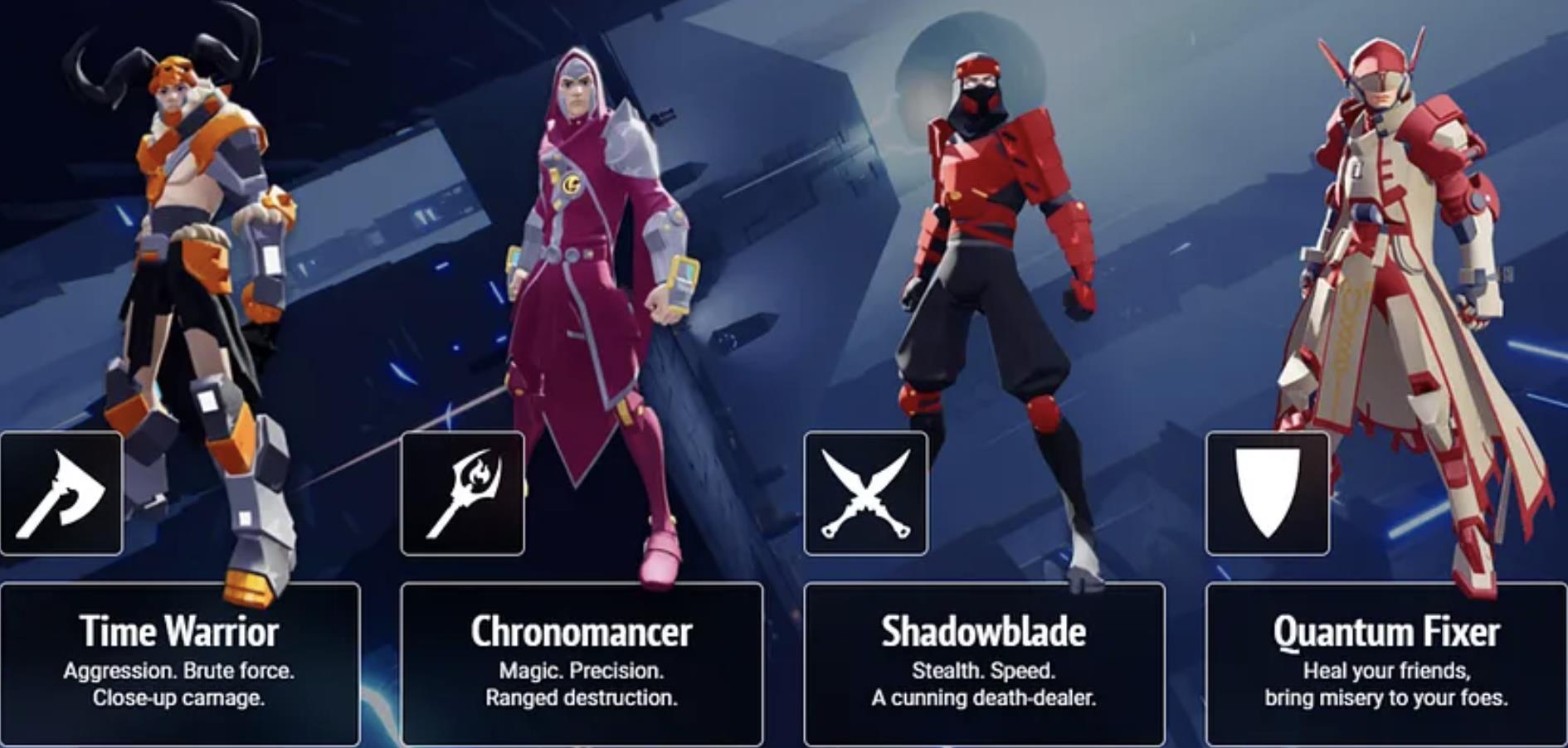
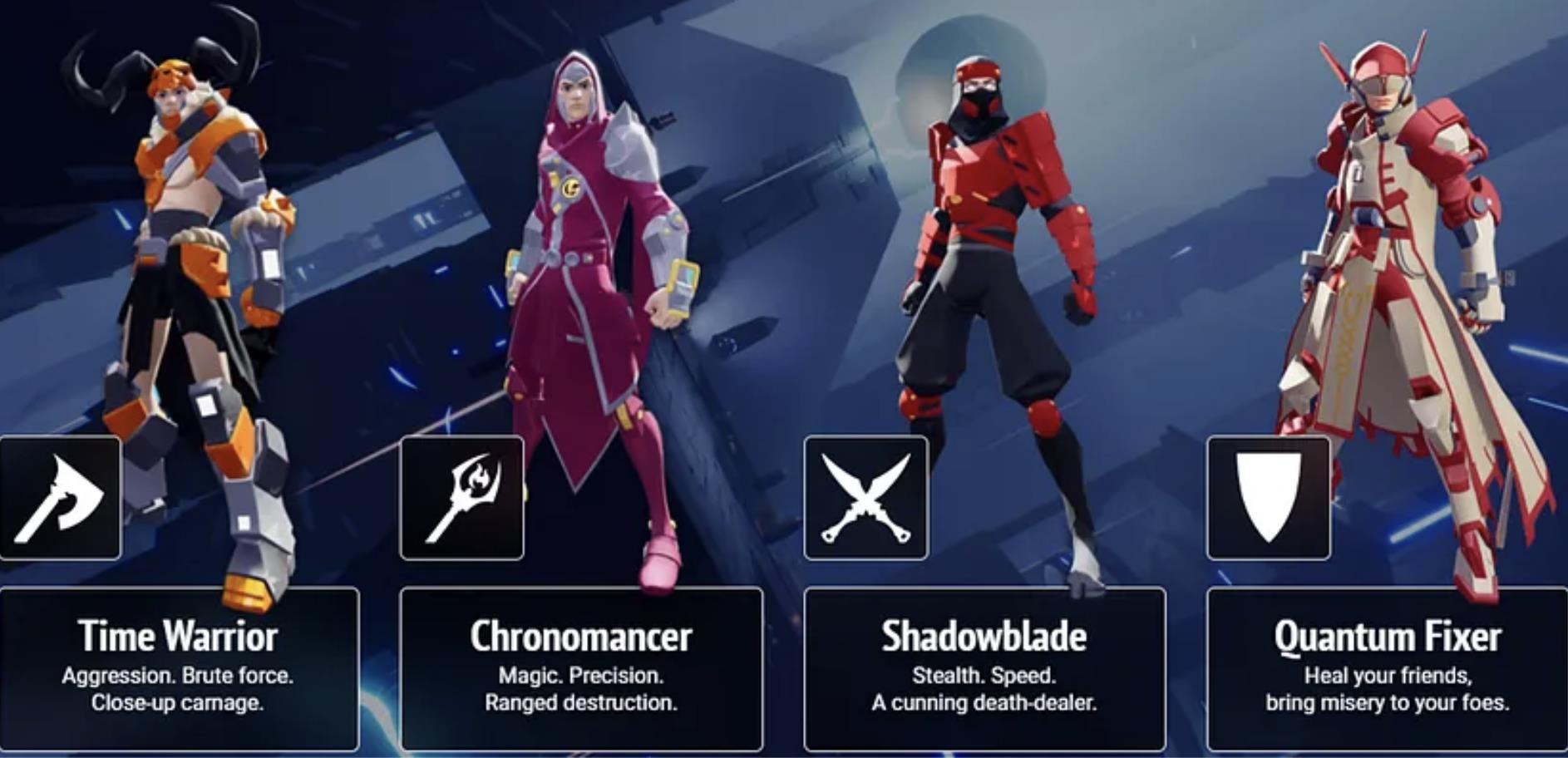 Figure 2-3 Big Time Game Characters
Figure 2-3 Big Time Game Characters
Currently, there are four character professions in the Big Time game, as shown in Figure 2-3:
• Time Warrior: Skilled in close combat, suitable as a tank; signature skills include Whirlwind Slash and Invincible Roar.
• Chronomancer: A long-range attacking mage capable of group output; signature skills include Fireball, Blizzard, and Time Stop.
• Shadowblade: Possesses high-speed movement and stealth abilities, suitable for single-target output; signature skills include Stealth, Backstab, and Bomb Trap.
• Quantum Fixer: Similar to a priest, capable of healing teammates, suitable as support; signature skills include Healing, Summon Turret, and Energy Recovery.
The four professions in Big Time are based on the traditional Western RPG professions of "warrior, mage, priest, and rogue," making it easier for players to quickly adapt to the game mechanics and choose their preferred playstyle. In addition to the four professions, Big Time also features a job change system. Players can use different "Pocket Watches" items in the game to change professions. Furthermore, after the v0.26 update, when players reach level 30, they can choose to change to two new professions, Techblade and Battlemancer, each with a new set of skills. The former is a combination of tank and mage, while the latter is a combination of rogue and priest.
In terms of growth elements, internal growth mechanisms include leveling up and skill points. In Big Time, players receive attribute points and skill points each time they level up. Attribute points can enhance the character's basic attributes, allowing players to equip better weapons and gear as their basic attributes improve, similar to traditional RPG gameplay. Skill points include active skills and general talents, with active skills related to the chosen profession and general talents being independent of the profession and always in effect.
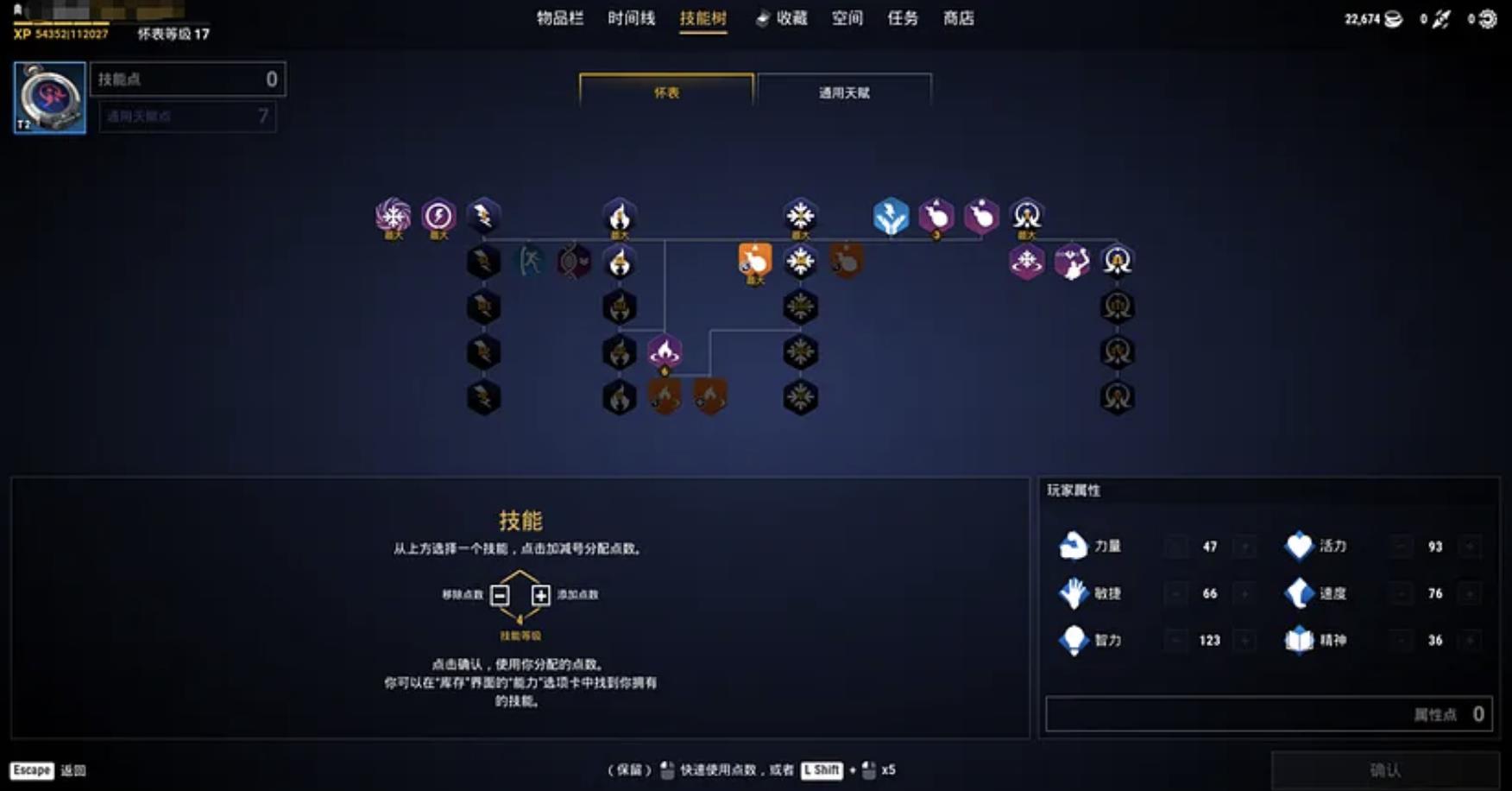 Figure 2-4 Leveling and Attribute Point System
Figure 2-4 Leveling and Attribute Point System
External growth mechanisms currently include the equipment and item systems.
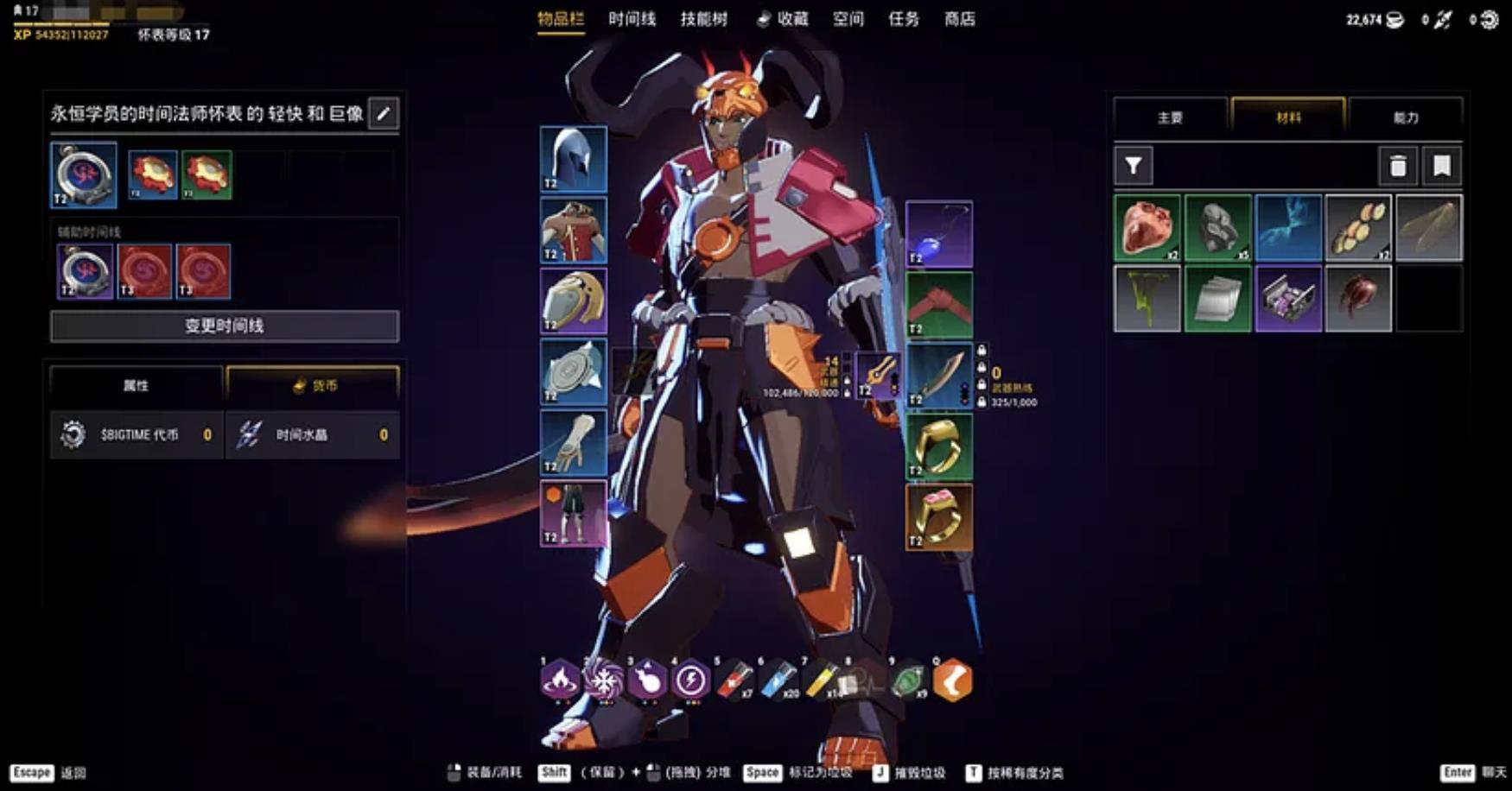 Figure 2-5 Equipment and Item System
Figure 2-5 Equipment and Item System
The equipment system currently includes gear, armor, shields, weapons, jewelry, and backpacks. Gear items can be equipped on the Pocket Watch to grant players additional abilities or item rewards. Weapons are directly equipped by players and currently include various types such as two-handed axes, one-handed hammers, two-handed hammers, one-handed swords, two-handed swords, dual blades, and two-handed staffs. The weapons that players can equip are linked to the player's profession, level, and basic attributes. Weapons provide a boost to the player's basic attributes and have a mutually restraining relationship with the defense type of the target. Armor includes helmets, shoulder armor, chest armor, gloves, and leg armor, as well as shields and jewelry, all of which can enhance the player's basic attributes. The backpack is used to store player items, providing additional inventory slots to assist players in the game.
The equipment system currently includes rarity and skin mechanisms. Equipment with higher rarity generally has a higher attribute bonus limit. The skin system is similar to the fashion system in Dungeon & Fighter (DNF) and can be crafted in the arsenal and forge in SPACE. Skins do not affect the attributes of the equipment itself and can be equipped by players in the collection section of the UI to showcase the skins they currently own. Equipment or skins can be obtained through monster drops, synthesis, participation in events, character progression, or purchasing corresponding packages, with skin NFTs available for trading as NFTs on Open Loot. More specific equipment forging mechanisms will be detailed in the NFT and SPACE sections.
In terms of the item system, the game includes many items, including energy potions, health potions, teammate teleportation potions, town teleportation scrolls, and life trees. These items can generally meet the players' needs for resource replenishment and fast travel and are typically obtained as loot from defeating monsters.
From the perspective of character and growth elements, Big Time largely draws on the character and growth design of mature MMORPGs. However, its free job change system will enrich the player's gaming experience. At the same time, this also poses a requirement for the game team to balance adjustments, as the lower job change threshold means that if a certain profession's abilities are particularly outstanding in the future, it may squeeze the survival space of other professions, affecting the game's playability.
2.4.3 Interaction Elements
The core gameplay mechanisms of the game can be distilled into the game's interaction elements. Currently, in the game, players can interact with the storyline, map, scenes, and other players. Both paying and non-paying players can experience the same game content in terms of character and growth elements, but paying players can enjoy a richer gaming experience in terms of interaction elements.
In the v0.27 version, players will be able to explore an entire map, which includes elements such as towns, forests, swamps, snow-capped mountains, towers, and dungeons, where interactive objects include NPCs, monsters, ores, teleportation gates, and other players.
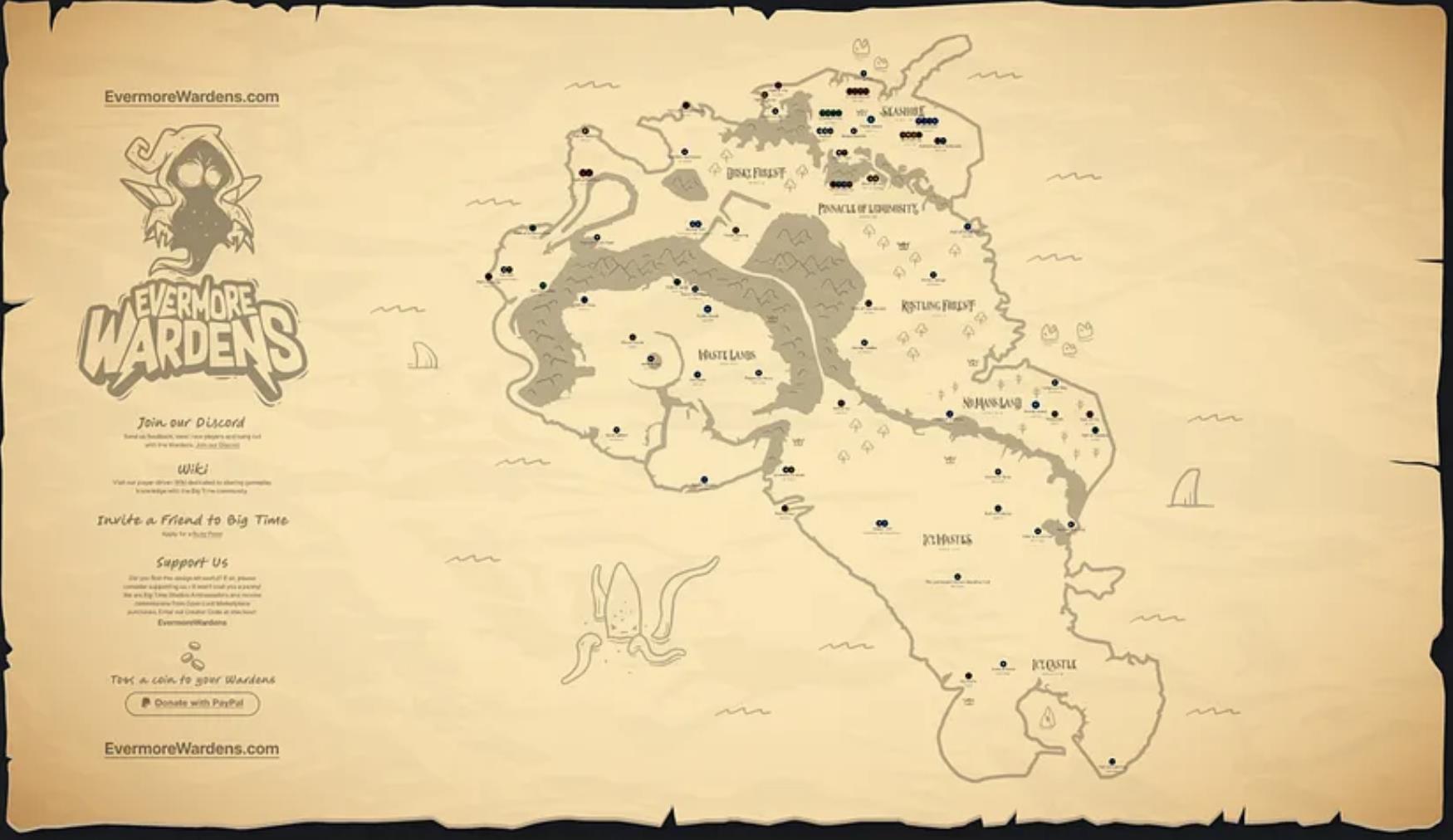
Figure 2-6 BigTime Game Map [14]
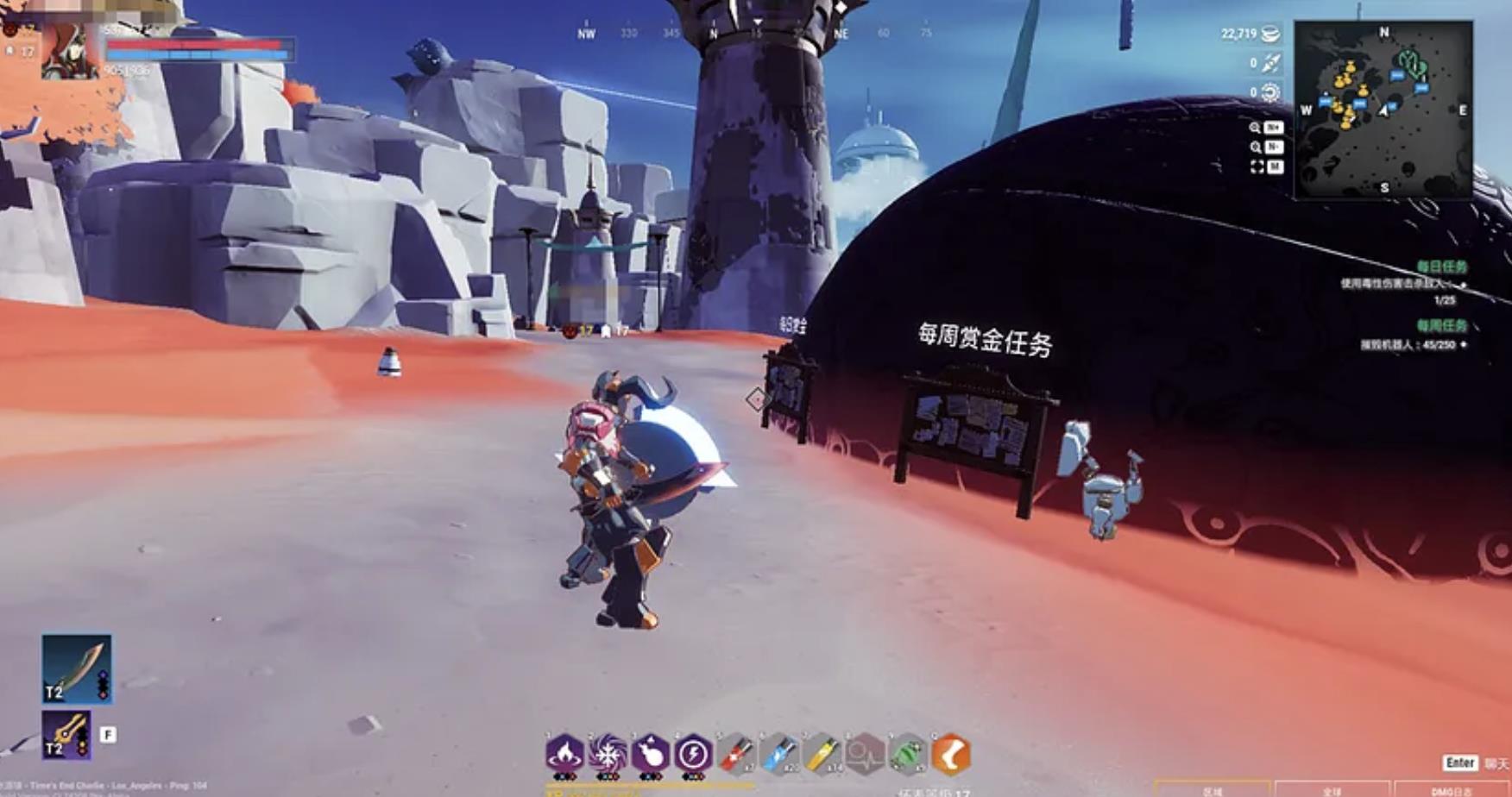
Figure 2-7 Interaction Elements
Players can interact with NPCs to complete item trades, learn skills, trigger storylines, and receive quests. Monsters and ores correspond to the game's combat and gathering mechanisms, and players can use the left and right mouse buttons to perform combos or use numeric keys to release corresponding skills or items to attack enemies.
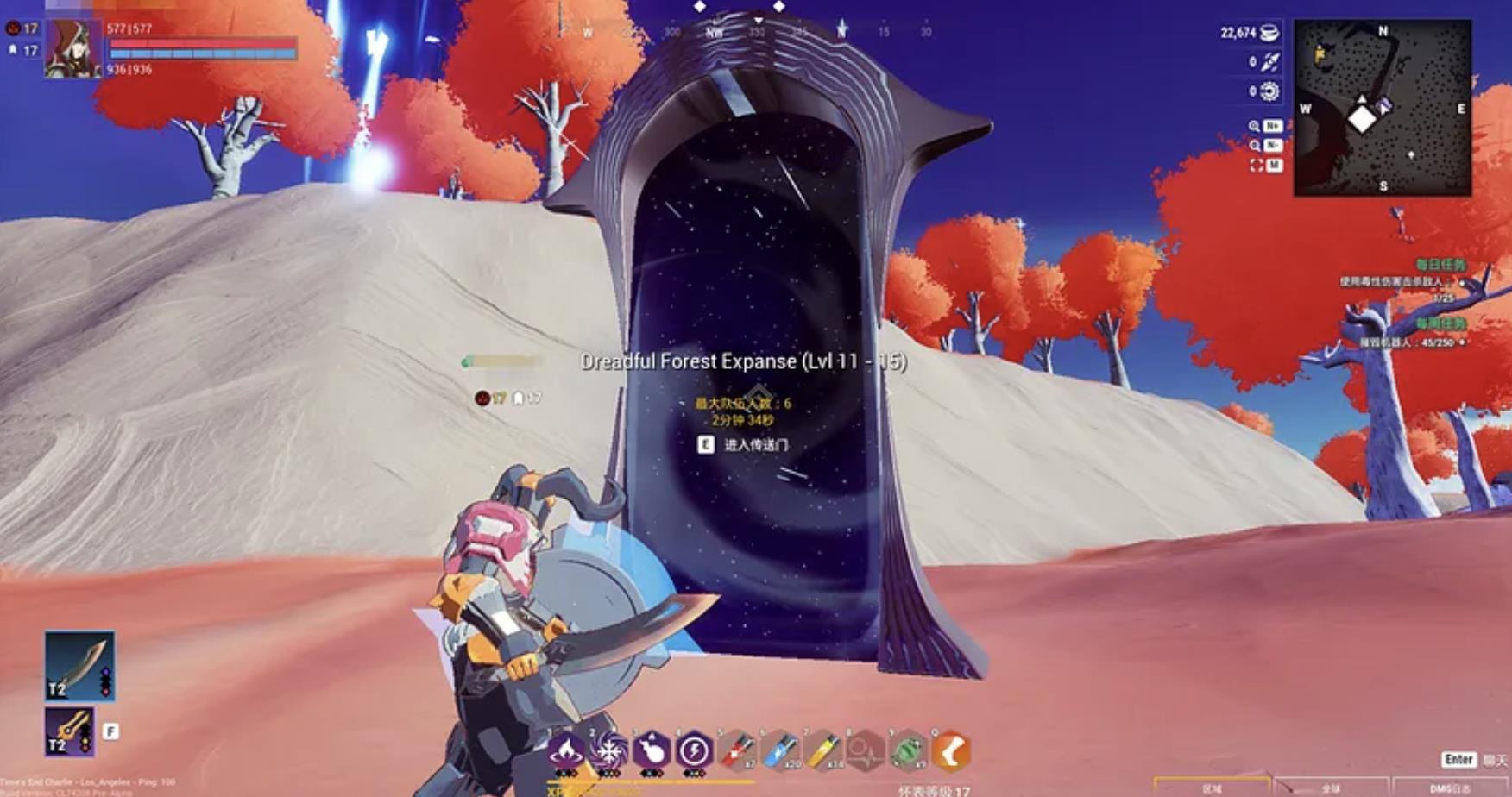
Figure 2-8 Dungeon Portal
The portal corresponds to the game's dungeon mechanism, with a maximum of 6 players per dungeon and recommended levels. After completing the dungeon's tasks in a team, players can enter the final boss room to defeat the boss and receive rich rewards. In future official versions, dungeon rewards will include pocket watches, coins, time crystals, BIGTIME tokens, equipment, skin fragments, bonus roll chips, NFTs, and more. In addition to regular dungeon portals, there is a high-reward dungeon called the Prestige Portal, which significantly increases the drop rate of rare items. Players need to meet the entry requirements for skin NFTs, which may include the type, theme, season, and color of the skin NFT, and then pay BIGTIME or time crystals as an entry fee. Players can also use the lucky wheel slots to provide additional bonuses for the high-reward dungeon.
Currently, the game's interaction mechanisms with other players include teaming up, player expressions, and chat functions, with features such as friends and guilds expected to be opened in future updates.
2.4.4 Resource Elements
In the upper left corner of the game's main UI map, three resource elements are displayed: coins, time crystals, and BIGTIME tokens. Coins can be obtained through defeating monsters, completing quests, trading loot, or mining, and are used to purchase regular equipment and items in the game.
Time crystals are the game's main in-game currency and are difficult to obtain through normal gameplay. Players can mainly purchase time crystals from Big Time through Open Loot, and time crystals are non-chain assets, once purchased, they are bound to the account and cannot be traded on the market. Currently, the price of 500 time crystals is approximately $5, and the price of 13,500 time crystals is approximately $100. Time crystals are mainly used to activate various functional NFTs, and a certain amount of time crystals is required in the process of using the arsenal, forge, and time guardian. In addition, time crystals can also be used to purchase some auxiliary items, such as additional hourglass equipment slots or to pay the entry fee for certain Prestige Portals.
BIGTIME tokens are the most important core assets in the game and are the final link in the game's economic mechanism, which will be discussed in section 2.4.7.
In addition to the three visible resource elements in the UI, there are four important resource elements related to functional NFTs in the game: cosmetic shards, workshop mod chips, prestige portal mod chips, and cosmetic scraps. Workshop mod chips and prestige portal mod chips are collectively referred to as bonus roll chips, dropped in game activities, and are non-chain assets, so they cannot be traded and are mainly used to exchange for functional NFTs and the lucky wheel of the Prestige Portal.
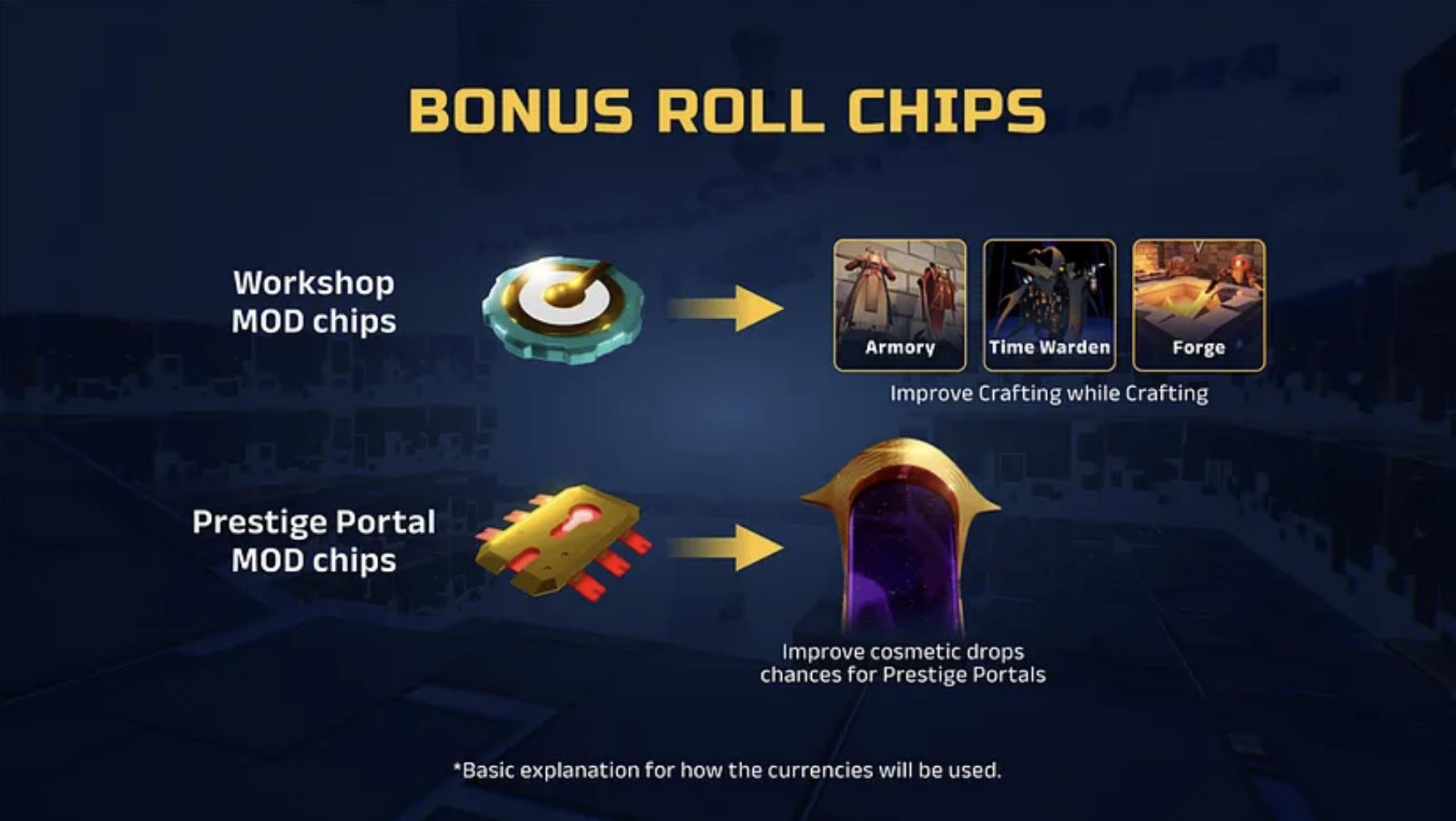
Figure 2-9 Workshop Mod Chips and Prestige Portal Mod Chips
All four are dropped from monsters in dungeons. Cosmetic shards are mainly used to synthesize refined cosmetic shards and then create or upgrade skin NFTs in the arsenal or forge. Workshop mod chips are mainly used to exchange for functional NFTs and can also be used to purchase the lucky wheel of functional NFTs. Prestige portal mod chips are mainly used to exchange for the lucky wheel of the Prestige Portal. Cosmetic scraps are mostly obtained by destroying skin NFTs and are mainly used to exchange for workshop mod chips and prestige portal mod chips.
2.4.5 NFT
There are two types of NFTs in the game, one is the skin NFT mentioned in the equipment section, and the other is the functional NFT. The difference between the two is that skin NFTs are products, while functional NFTs are production tools. The former can enhance the user's gaming experience by improving the visual and auditory performance of in-game items such as armor and weapons, showcasing the player's status. Players with skin NFTs also have the qualification to access exclusive content such as exclusive scenes or the Prestige Portal. To ensure game balance, skin NFTs will not affect the original game values of in-game items. The latter is mainly used to produce skin NFTs and maintain the game's economic cycle with BIGTIME tokens.
Skin NFTs are divided into two categories: craftable skin NFTs and non-craftable skin NFTs. The former can be crafted using functional NFTs, while the latter can only be randomly dropped in the game. Functional NFTs currently include three types: forge, arsenal, and time guardian, all of which can only be used after connecting to the personal metaverse SPACE. In the forge and arsenal, players need to invest a certain amount of resources, such as BIGTIME tokens, time crystals, and skin fragments, to create and upgrade skin NFTs. Three low-rarity craftable skin NFTs will be able to exchange for higher-level craftable skin NFTs, which will become an important part of the seasonal competition in the future.
The time guardian is the most complex functional NFT in the game and will be used to produce BIGTIME tokens. Players need to first invest time crystals to create an hourglass, then use the hourglass and time crystals to charge it before it can produce BIGTIME tokens. The hourglass is a consumable resource, and when it is depleted, players need to use time crystals in the time guardian to recharge it to continue producing BIGTIME tokens.
Each activity in the functional NFTs, including refining, crafting, and upgrading skin NFTs, can choose to use the lucky wheel, which is obtained by exchanging workshop mod chips and can provide additional bonuses to the action in the form of a lottery. The level of the functional NFT determines the available slots for the lucky wheel, and multiple different lucky wheel bonuses can be stacked for a single action. All activities in the functional NFTs can earn functional NFT experience points, and when the experience points reach the upgrade standard, players can pay time crystals to upgrade the functional NFT. After upgrading, the functional NFT will have higher production efficiency, additional lucky wheel slots, and bonus effects.
In addition to the above functions, functional NFTs also have different types, different types of functional NFTs have different color classifications and special bonus types. In addition, the type of functional NFT is also linked to its rarity, with the top three rare functional NFTs all being Triumph types.
The forge currently has 10 types:
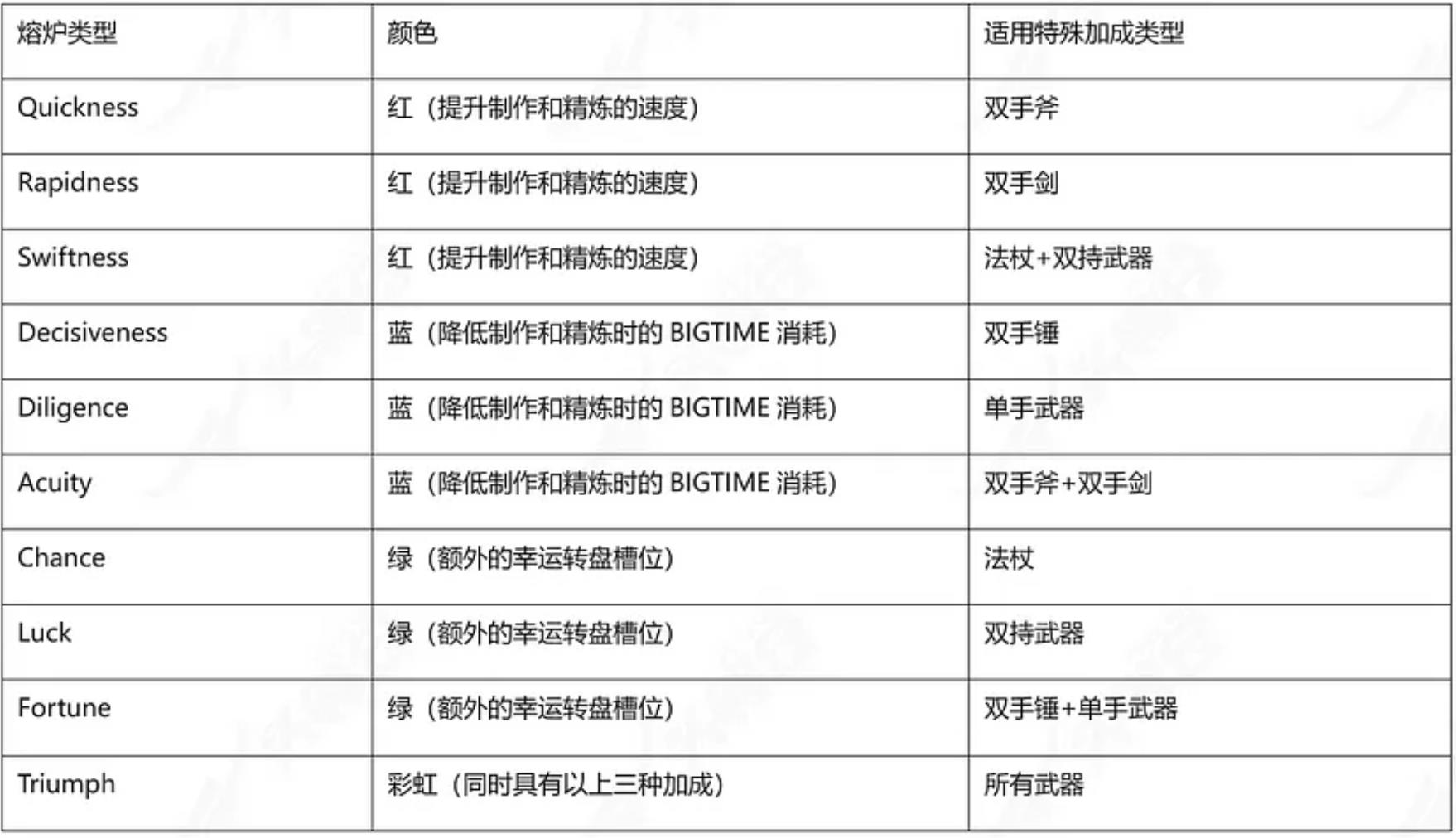
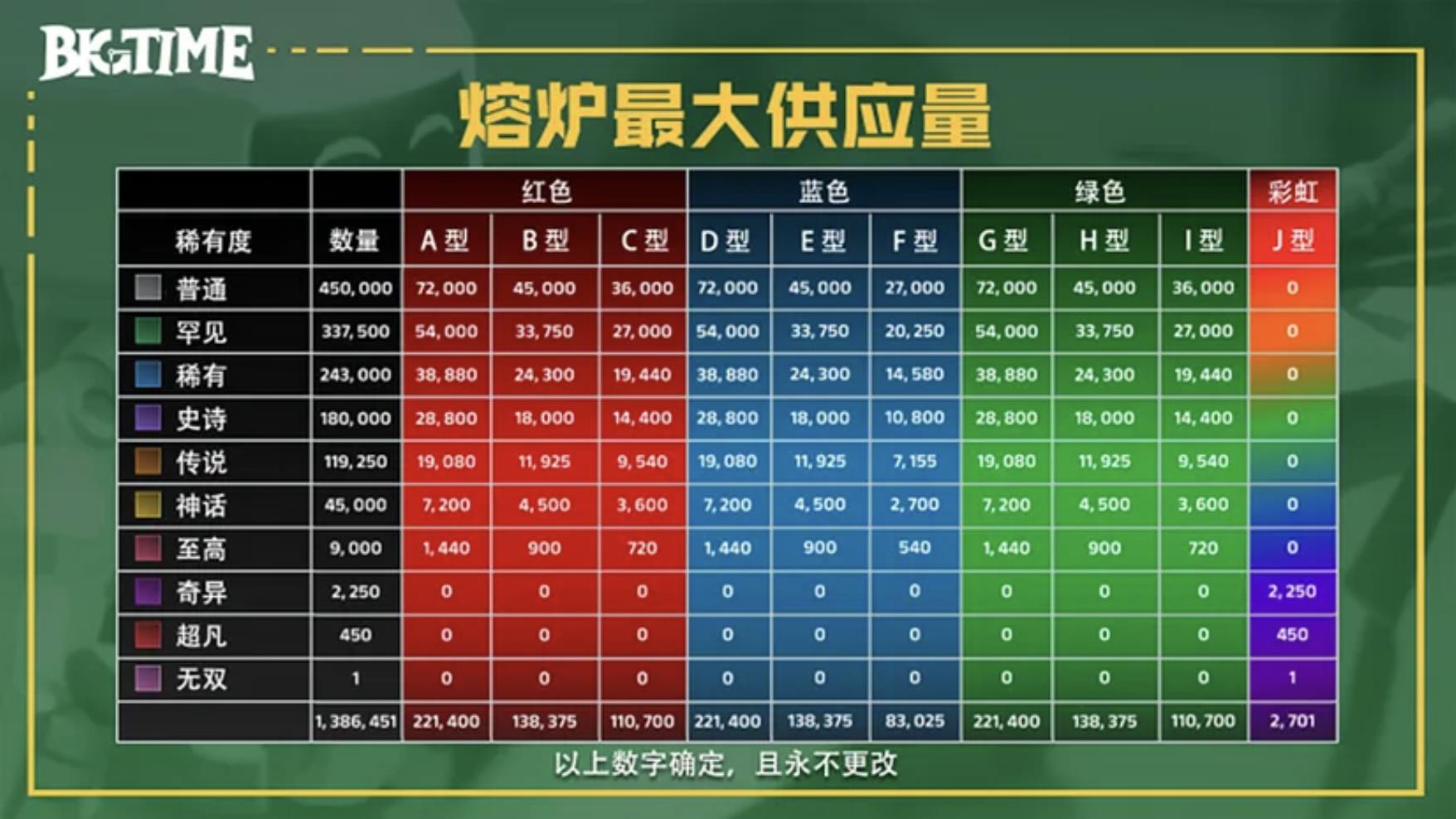
Figure 2-10 Maximum Supply of Forge and Arsenal by Different Types and Rarity
The arsenal currently has 10 types:
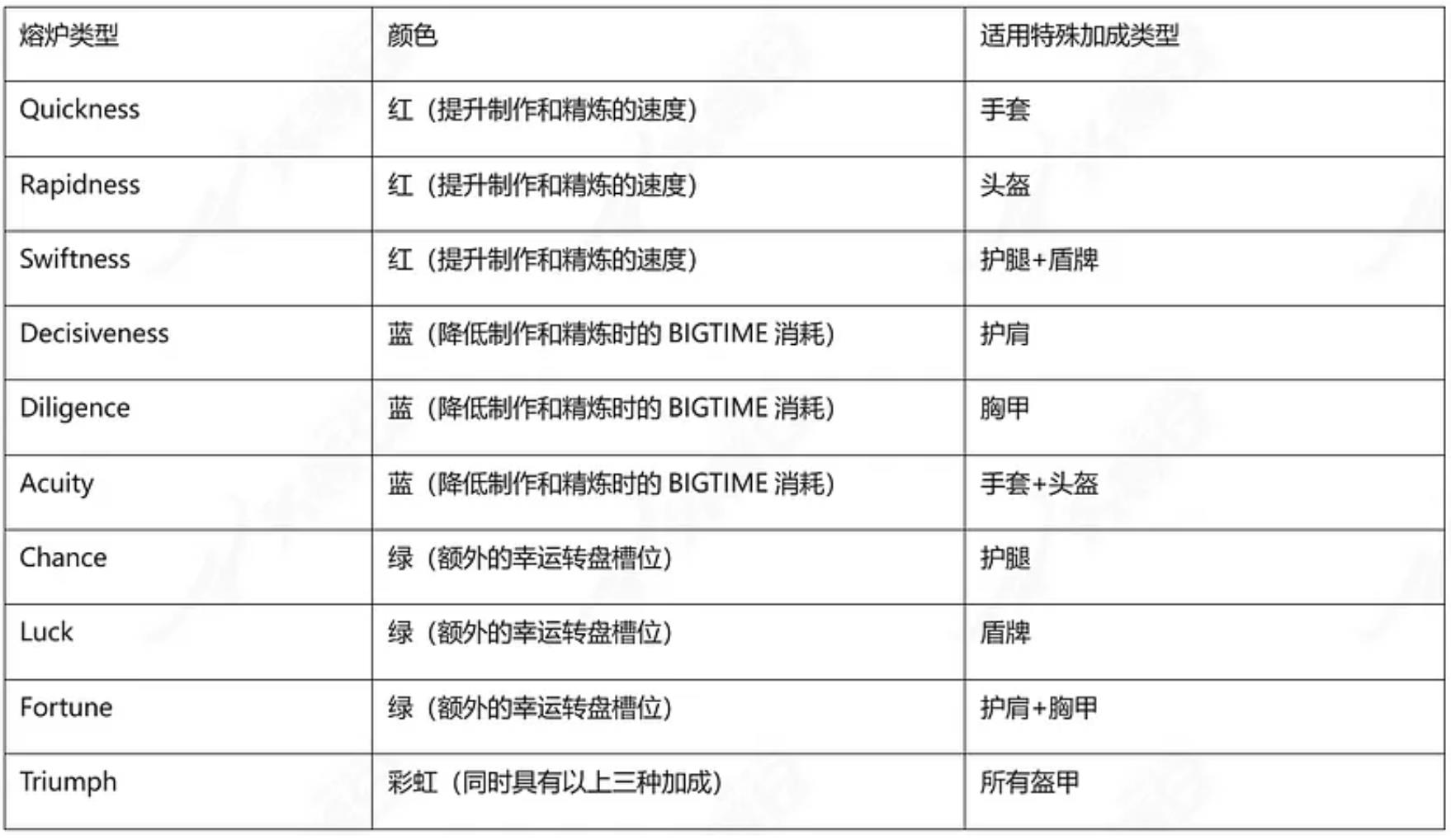
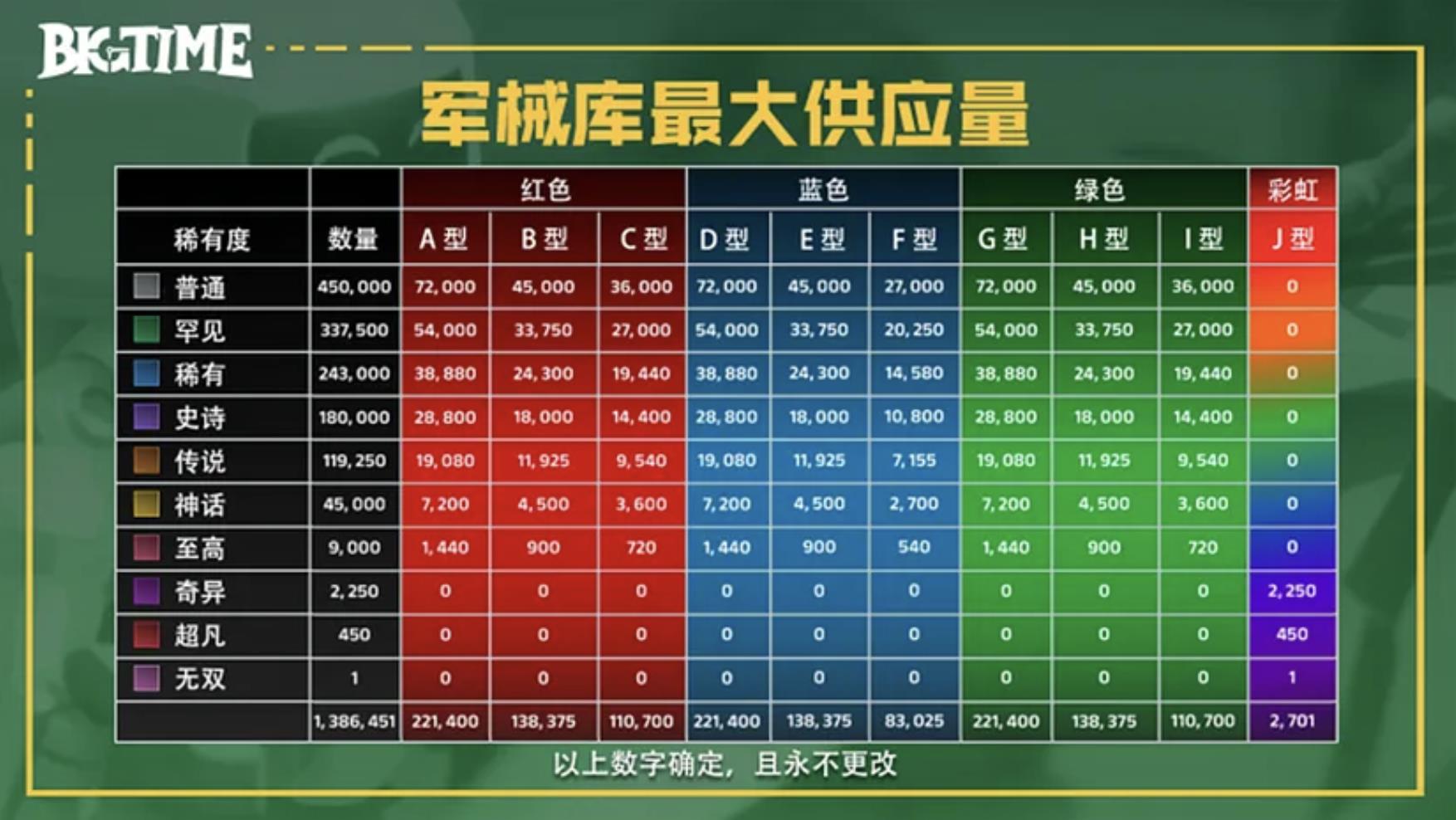
Figure 2-11 Maximum Supply of Arsenal by Different Types and Rarity
Unlike the forge and arsenal, the time guardian currently has only 4 types:

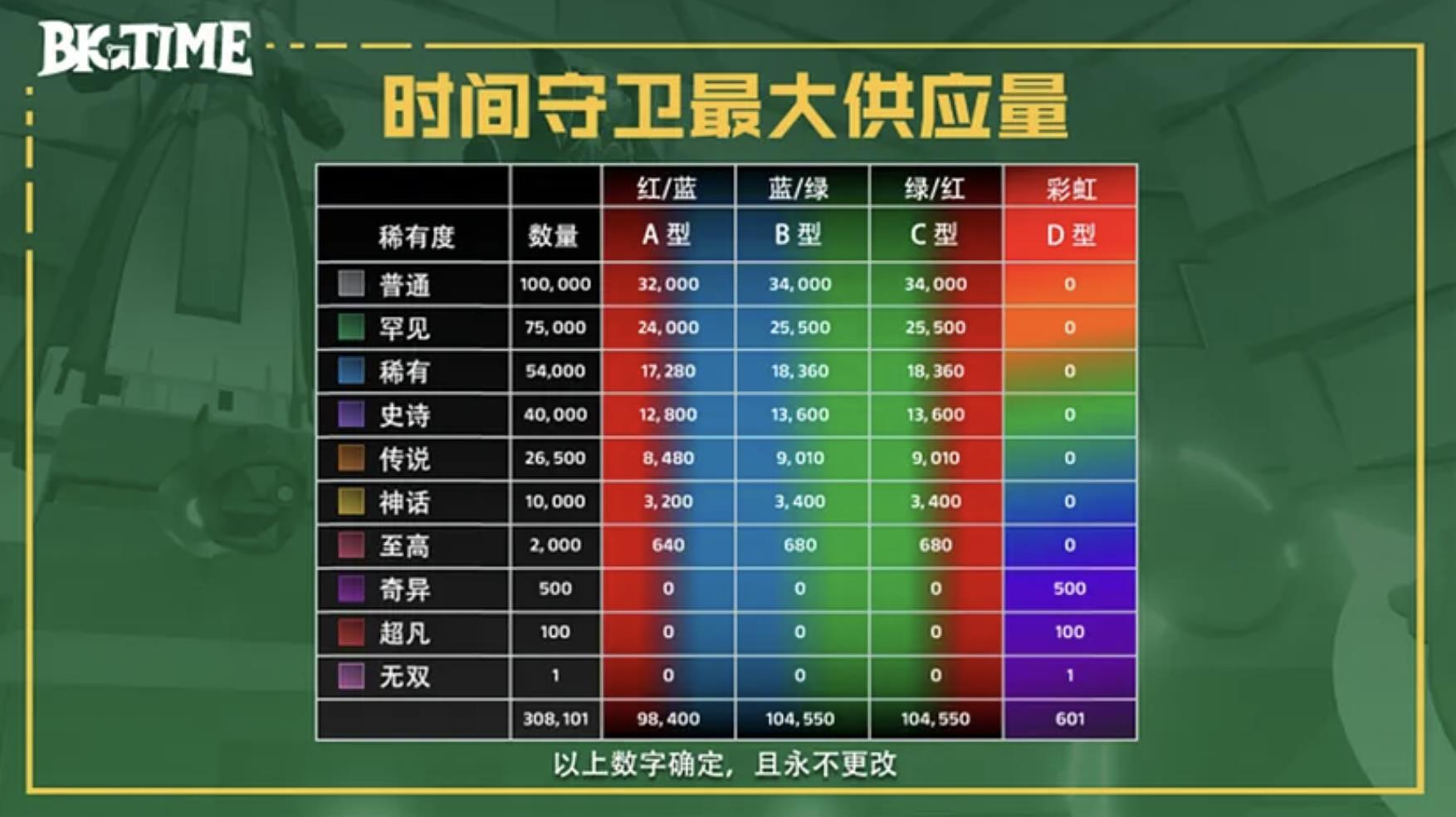
Figure 2-12 Maximum Supply of Time Guardian by Different Types and Rarity
In addition to the individual bonuses of each functional NFT, players can also obtain set bonuses based on the various types of functional NFTs in SPACE. The rewards for set bonuses are similar to individual bonuses and can be stacked. Red increases the speed of crafting and refining, blue reduces the BIGTIME consumption during crafting and refining, and green adds extra lucky wheel slots.
Finally, the official emphasizes that all functional NFTs will have a fixed and unchangeable issuance quantity, but new skin NFTs will be released on a seasonal basis, and the maximum issuance quantity of skin NFTs for a single season will be determined at the beginning of the season.
2.4.6 SPACE
SPACE is an important game feature that distinguishes between paying and non-paying players, similar to the concept of "land" in other metaverses. In the game, players can summon their own metaverse portal on the map by clicking a specific button and then enter it. Both free and paying players can have their own personal metaverse in the game, but only players with SPACE can perform special operations in the expanded space of SPACE.
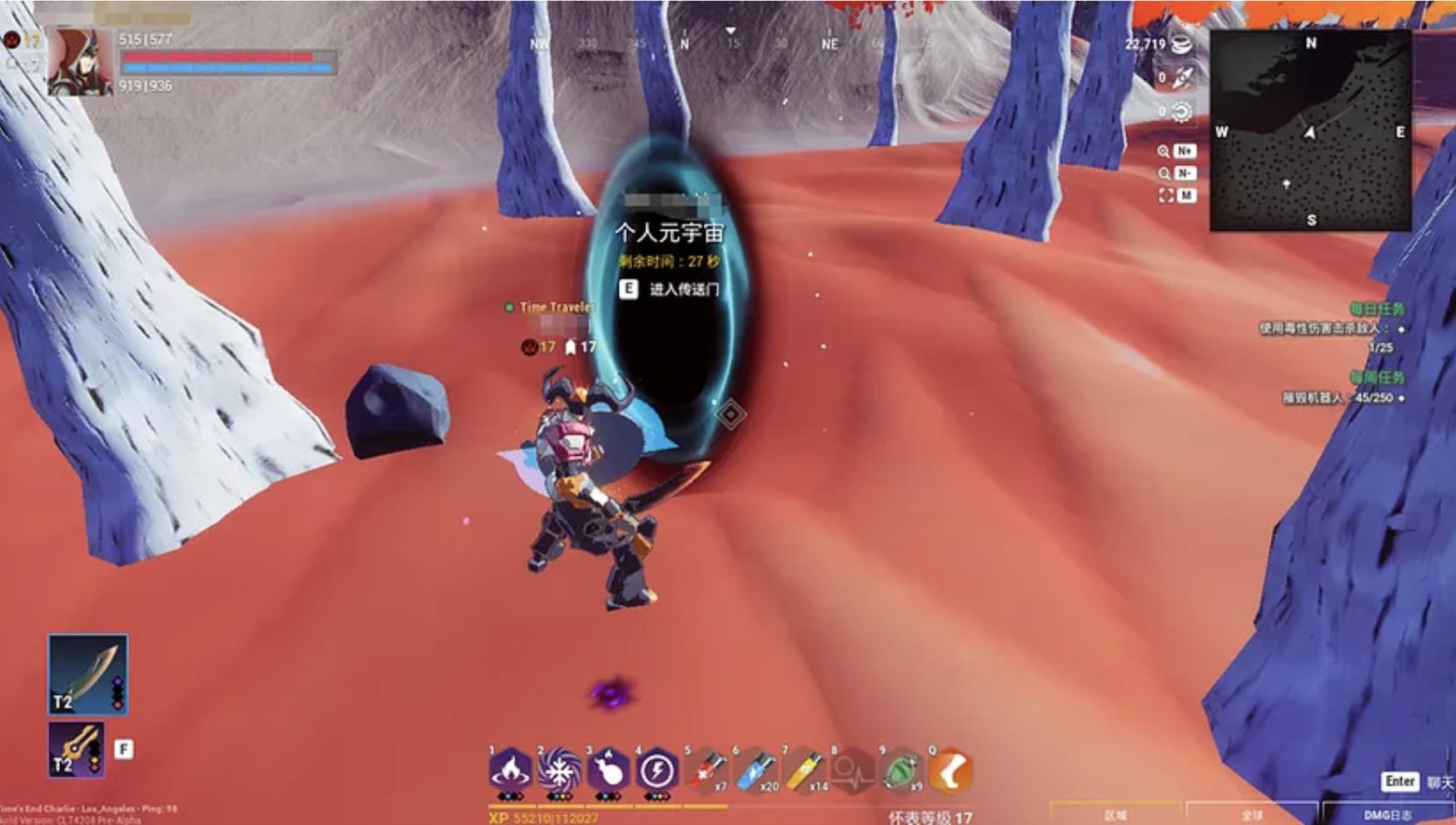
Figure 2-13 Personal SPACE Portal
SPACE currently has four functions:
1) Expand personal metaverse. The design of SPACE space is like building blocks, with each SPACE having an entrance and multiple exits. Players need to create their personal metaverse through the entrance and then connect to other SPACE or functional NFTs (arsenal, forge, and time guardian) through the exits. Different sizes of SPACE have different numbers of exits.
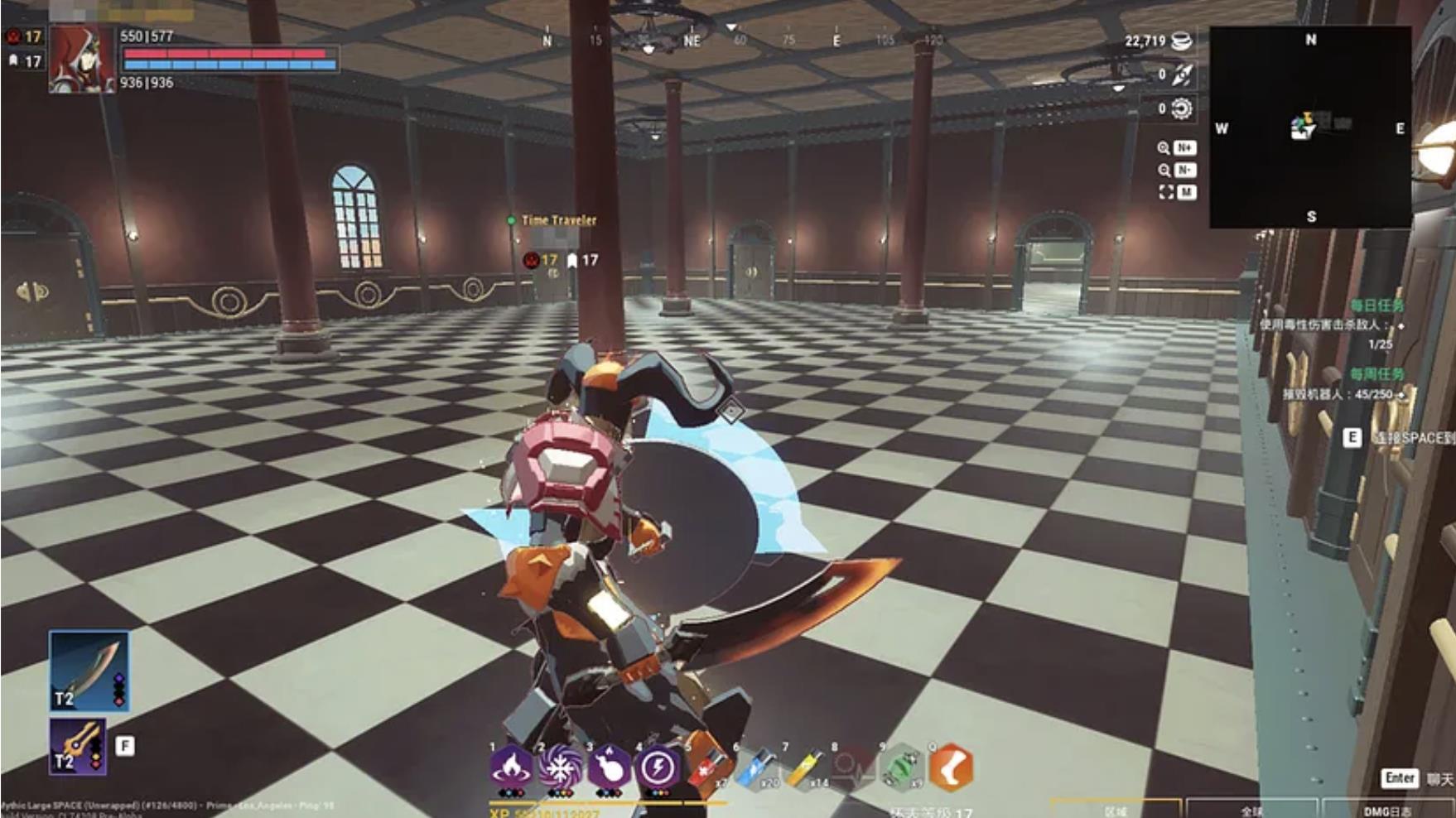
Figure 2-14 Inside SPACE
2) Use functional NFTs. The arsenal, forge, and time guardian can only be used when connected through SPACE.
3) Place skin NFTs. Players can display skin NFTs obtained during the game in their personal metaverse or make some personalized modifications.
4) Obtain cracked hourglasses. Cracked hourglasses can be used to produce the in-game token BIGTIME.
5) Integrate social functions. Players will be able to invite other players to visit their personal metaverse and interact with them.
SPACE can currently only be obtained through purchase. Different sizes and rarities of SPACE have fixed maximum issuance quantities:
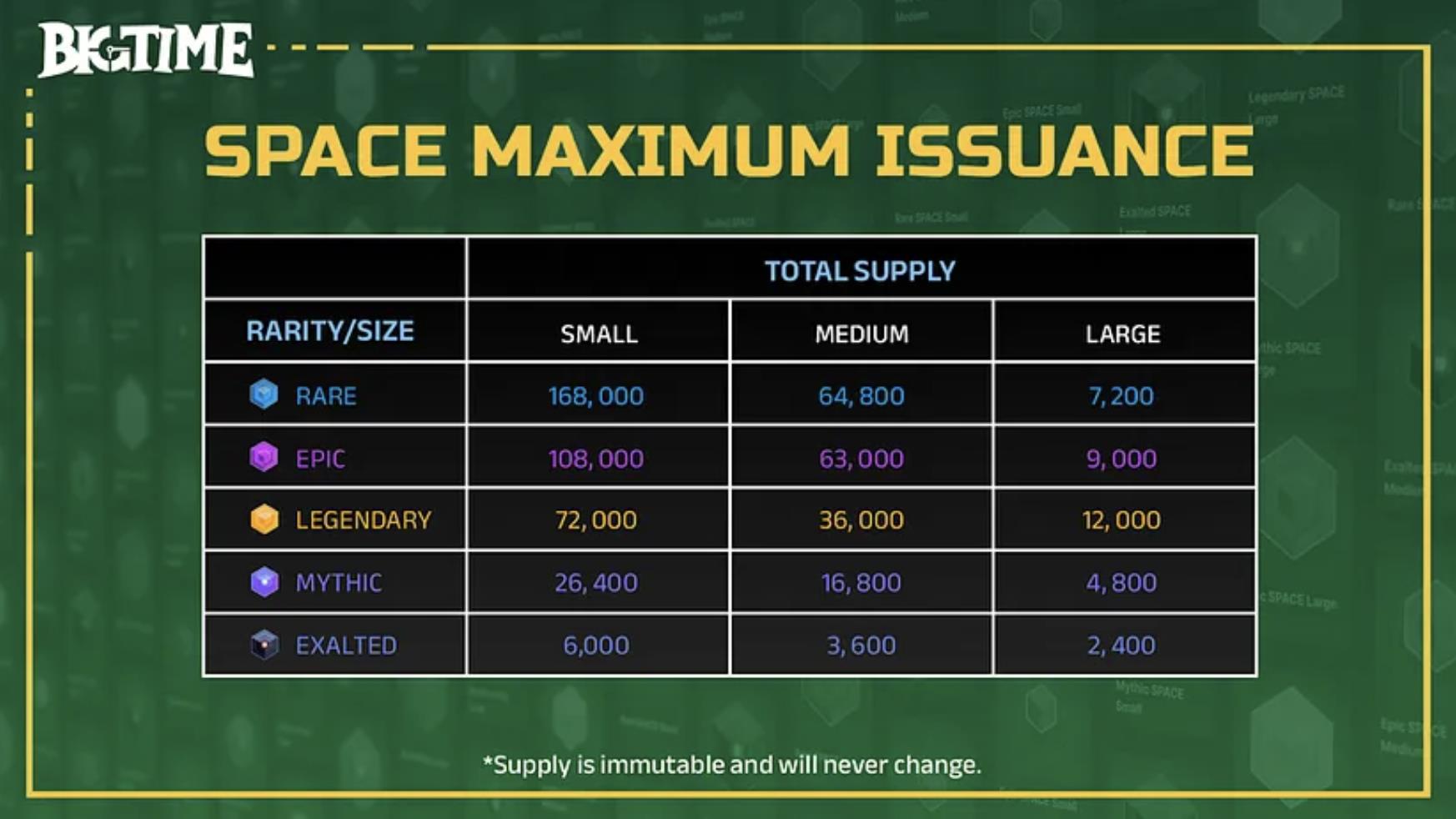
Figure 2-15 Maximum Supply of SPACE by Different Rarity and Size
The size of SPACE will affect the number of exits in SPACE, which in turn affects the number of components that SPACE can connect to.
Except for the Exalted rarity, all SPACE have three sizes: small, medium, and large, with 2, 3, and 5 exits, respectively. The Exalted rarity has one more exit than other rarities.
In addition to affecting the number of exits in SPACE, rarity also restricts the functional NFTs that can be connected to SPACE. High-rarity functional NFTs can only be connected and used on high-rarity SPACE. At the same time, the rarity of SPACE will affect the rarity and drop rate of cracked hourglasses, and the size of SPACE will affect the number of cracked hourglasses dropped, thereby affecting the supply of BIGTIME tokens.
In the future, Big Time will also introduce a SPACE leasing system to allow more players to experience the richer game content provided by SPACE.
2.4.7 Game Economic Mechanism
The game's economic mechanism built by Big Time revolves around the BIGTIME token.
The BIGTIME token mainly has the following functions:
1) Used to refine or create and upgrade skin fragments in the forge and arsenal.
2) Pay the entry fee for the Prestige Portal.
The total supply of BIGTIME tokens is 5,000,000,000, and theoretically, it will be entirely generated in the game through gameplay, rather than being introduced into the game through issuance, and there are no token sales aimed at investors.
Specific methods of obtaining include the following three:
1) Cracked hourglasses randomly drop in personal metaverse SPACE as a disposable item that can be equipped to produce BIGTIME tokens. Like time crystals, cracked hourglasses are non-chain assets, bound to the player's account, and cannot be traded.
2) Spend time crystals in the functional NFT time guardian to create hourglasses and equip them, then continue to spend time crystals to charge the hourglasses and produce BIGTIME tokens.
3) Purchase from the market or receive team airdrops of already produced BIGTIME tokens.
The generation mechanism of BIGTIME determines that the supply of BIGTIME tokens will be related to the allocation of in-game resources for the majority of the time, ensuring that the entire game's economic model has a certain degree of stability and elasticity. As the producer of BIGTIME in the game, the main direct resources that need to be invested are hourglasses and time crystals. The price of time crystals is fixed and denominated in USD, while the price of hourglasses fluctuates with market supply and demand. The former ensures that if the output of BIGTIME is lower than the cost, the producer will reduce token supply, thereby stabilizing the game economy. The latter ensures that the output of BIGTIME is related to market activity, that is, it has a certain degree of correlation with actual player demand, thereby increasing the elasticity of the game economy.
In addition to the BIGTIME token, assets that can be traded on Open Loot also include skin fragments, SPACE NFTs, decorative NFTs, and functional NFTs. Therefore, there are two paths to participate in the complete economic cycle of the game in Big Time:
1) Defeat monsters, clear dungeons, and trade skin fragments on the market.
2) Defeat monsters, clear dungeons, and trade non-craftable skin NFTs on the market.
Here is the translation of the provided markdown:
The above are the two paths for free players to participate in the game's economic cycle. Due to the low drop rates of NFTs and rare resources in regular dungeons, free players need to invest a lot of time and effort. Trading skin fragments will be one of the few behaviors in which free players can actually participate in the complete game economy cycle. However, since on-chain assets do not significantly affect the game's balance, free players can still experience most of the game's fun without involving on-chain assets.
For paying players, how to participate in the game's economic cycle is more strategic. Each paying player should determine the proportion of resources such as time crystals, BIGTIME tokens, and skin fragments to use in order to produce more skin NFTs and BIGTIME tokens for trading using SPACE and functional NFTs. Additionally, the existence of mechanisms such as the Prestige Portal can further enrich the gaming experience for paying players and increase their participation in the game.
Overall, the game's economic mechanism design in Big Time is very clever, ensuring that the in-game economic cycle has a certain elasticity on a stable basis, and ensuring that both free and paying players can have a rich gaming experience. However, this economic mechanism also places high demands on players' strategic allocation of in-game resources, requiring players to invest a certain amount of resources to find their suitable position in the game.
2.4.8 Airdrops
The Big Time team will airdrop early buyers of game NFTs and early participants in the game to thank them for their support.
There are two types of airdrops. The first type is the airdrop of mystery gift boxes, with a total of 153,000 boxes, each containing a functional NFT with different drop rates based on rarity. The more NFTs a user account has, the higher their rarity, the higher the value of their assets, or the more game tasks and dungeons they complete, the higher the value of the airdrop they can receive.
The other type is the airdrop of BIGTIME tokens. According to Big Time's current airdrop plan, the total token airdrop amount will reach 2.6% of the total supply, which is 130,000,000 BIGTIME tokens. During the preseason, the official will airdrop 97,500,000 BIGTIME tokens, and the remaining tokens will be used for other airdrops and marketing plans. The above airdrops will take place at the end of the first three months after the start of the preseason, and the amount of the airdrop will be based on the real-time leaderboard of points in each user account. Points in user accounts will be calculated based on the following behaviors:
1) In-game leveling. The higher the level a player reaches, the higher the point reward.
2) Use of functional NFTs. Behaviors that can earn points include refining cosmetic fragments, crafting cosmetics, crafting hourglasses, charging hourglasses, and dismantling cracked hourglasses.
3) Participation in the Prestige Portal.
4) Inviting friends. Inviting players will receive 50% of the invited player's points as a reward.
In short, the more players participate in Big Time, and the more collectibles they have, the higher the probability of receiving airdrops, and the richer the rewards they will receive. However, the specific details of the airdrop plan may be subject to further adjustments by the Big Time team in the future.
2.4.9 Seasonal Competitions and Rewards
After the public beta, Big Time will update major versions every 90 days, with each major update including the following content:
1) Brand new fixed quantity of skin NFTs, including craftable and non-craftable skin NFTs.
2) New seasonal skin fragments and refined skin fragments.
3) New special events and game content.
In addition, each season will also feature a skin NFT synthesis competition, known as the Unparalleled Challenge. Only one unique (Unique) rarity skin NFT will appear in each season. The player who first crafts the unique skin NFT will win the competition for the season. According to Big Time's skin rarity mechanism, synthesizing a unique rarity skin will consume 19,683 common future rarity skins. Big Time may introduce more activities to encourage players or guilds to participate in this competition.
2.4.10 Game Experience
• Game Configuration
Since Big Time is designed to be comparable to traditional AAA games, it has certain hardware requirements. The current minimum system requirements are as follows:
Graphics card: GeForce GTX 1060 / Radeon Rx 580 or higher Memory: 8GB RAM API interface: DirectX 11 or higher Processor: Intel core i5 4430 / AMD FX 6300 Storage space: 23GB Note: The above specifications may be adjusted based on future game development.
Currently, although Big Time cannot yet be compared to traditional AAA games, from the perspective of blockchain games, Big Time far exceeds the poorly made blockchain games currently on the market in terms of game graphics, gameplay, sound effects, and systems, reaching the level of a qualified independent game in the traditional gaming industry.
However, due to Big Time's specific requirements for configuration and the need for certain operations, it inevitably limits the entry of a certain group of people. Therefore, the key is whether the game can successfully stand out, that is, whether the game is outstanding, whether the built-in economic incentive measures, and other factors can attract blockchain players and players from the traditional gaming industry.
• Game Experience
In terms of the overall game testing results, version 0.27 of Big Time already has the prototype of an MMORPG game.
First, the gameplay mechanics of the game have been established, but not all systems have been fully implemented in the current beta testing, such as tokens, guilds, and the like, which will appear in subsequent updates. The dungeons and main storyline challenges that can be experienced smoothly in the current beta have basically reached the standard of a normal game.
Second, in terms of the game's audiovisual performance, it is generally above average. The visual performance is slightly better than expected, but the overall color tone is relatively monotonous, and the elements are relatively scarce, leading to a feeling of fatigue after a long time of gameplay.
In terms of the overall game process, players need at least 30 hours to experience all the elements of the current version, and the game itself has a medium volume. However, more storyline and dungeons in the future still need to be provided through future game updates.
• Payment System
If players want to purchase NFT assets on Big Time, they only need to log in through their Google account on the Big Time official website, then bind their phone number or Google Authenticator, and finally bind their bank account or add USDC to make purchases. Of course, for users experienced in on-chain transfers, they can also create a new encrypted wallet and conduct transactions.
Note: Currently, the Big Time Marketplace only supports USDC payments, but it is expected to support ETH payments in the future.
The NFT purchase process in Big Time is relatively convenient in operation, as players do not need to learn how to use digital wallets. They only need to log in with their Google account and bind their bank account to make purchases, greatly reducing the entry barrier for users. It should be noted that on the Big Time NFT trading platform Open Loot, large deposits (over $2,000 within 24 hours) or any withdrawal operations require the completion of the corresponding KYC verification. Currently, one KYC verification can only be bound to one account.
2.5 Technology
2.5.1 Procedural Content Generation Technology
Big Time is built on Ethereum and uses Procedural Content Generation technology to expand off-chain scale.
2.5.1 Procedural Content Generation Technology
Procedural content generation involves inputting feature parameters and basic materials, and then using a series of customized (or somewhat random) algorithms to generate game content in large quantities in real-time or offline.
As game developers continue to grow and industrialize, the use of PCG has become mainstream in game development in recent years. In game production, PCG technology has several advantages:
1) It can significantly increase the production speed of game assets, reduce costs, and have a low error rate. This is crucial for optimizing control over large-scale game project outsourcing.
2) PCG generates a massive amount of resources, allowing for a lot of innovation in gameplay by continuously generating random content, stimulating the imagination of game designers.
3) It can dynamically generate an unlimited amount of new content in real-time within limited hard drive space, saving hard drive space and allowing players to repeatedly play through newly generated levels. It can also be computed offline to optimize game performance, giving players a vast space for exploration.
Popular traditional PC games such as "EVE," "Horizon: Zero Dawn," "Red Dead Redemption," "FarCry," "GTA," and "Minecraft" have all been built using the underlying technology of PCG.
Big Time uses PCG technology to create a vast game world for players, bringing more fun and playability, and increasing the game's exploration cycle.
2.5.2 Vault Technology
One of the most groundbreaking components integrated into Big Time is its patented Vault technology.
According to the team, Vault technology can: help users reduce the management of external wallets, self-custody assets, and eliminate expensive on-chain transactions. Players can enjoy benefits such as instant transaction settlement without setting up and managing their own encrypted wallets or spending network fees. The way this goal is achieved is mainly because the team stores Big Time's game items in its off-chain Vault custody system.
In simple terms, Big Time has created a private database through Vault technology.
Through Vault, Big Time stores the records of created or purchased items in its own database. From a technical standpoint, Big Time does not automatically mint NFTs on the blockchain, allowing NFTs and regular items to coexist, thus keeping transaction costs low. On the other hand, players can transfer assets from off-chain to on-chain at any time.
Additionally, Big Time's CEO, Ari Meilich, has stated that if there is enough demand for Big Time, the studio will design new ways for players to extract their assets and transfer them to any desired blockchain, which could mean that Big Time's SPACE in-game NFTs may soon become cross-chain assets.
Summary
From the team's perspective, the Big Time team has a solid background in game and crypto fields, with core members having experience in developing large games or working for major game companies. However, compared to the first research report in May 2022, there have been some changes in the core team members of Big Time. The departure of the product director and the game economic model design director may have had a certain impact on the game's development and delivery, with subsequent work being taken over by other experts deeply rooted in the game industry. Additionally, as Big Time Studios is a fully remote game studio worldwide, this may also have a certain impact on the timely delivery of the game.
In terms of funding, Big Time has raised over $90 million through primary market financing and NFT sales, which is enough to support the development of a AAA-level game. After the game goes live, the project team can continue to sustainably operate through the sale of game resources.
In terms of the game's core mechanics, Big Time has largely borrowed from the mature role and growth design of MMORPGs, but its free job change system will enrich the player's gaming experience. However, this also places demands on the game team's balance adjustments, as the lower job change threshold means that if a certain profession's abilities are particularly outstanding, it will squeeze the survival space of other professions, affecting the game's playability.
In terms of the game's economic mechanism, Big Time's design is very clever, ensuring that the in-game economic cycle has a certain elasticity on a stable basis, and ensuring that both free and paying players can have a rich gaming experience. However, this economic mechanism also places high demands on players' strategic allocation of in-game resources.
In terms of actual game experience, the game already has a certain level of playability, but it will require more iterations in the future to improve the game's visual performance and gameplay mechanics.
In terms of the game's entry barrier, the game's hardware requirements do not seem to be high at the moment, but players need to meet certain requirements to participate in the preseason.
3. Development
3.1 History
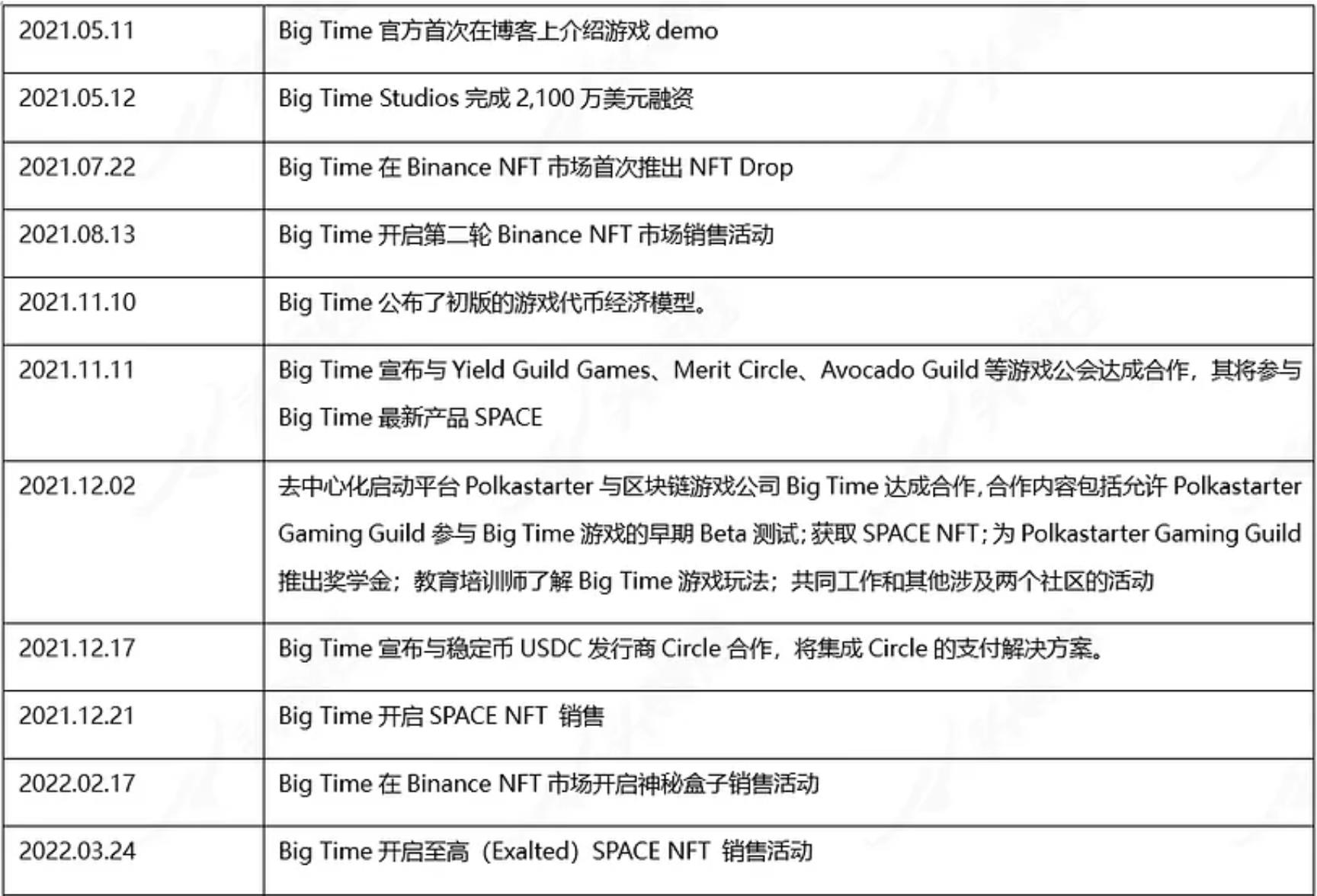
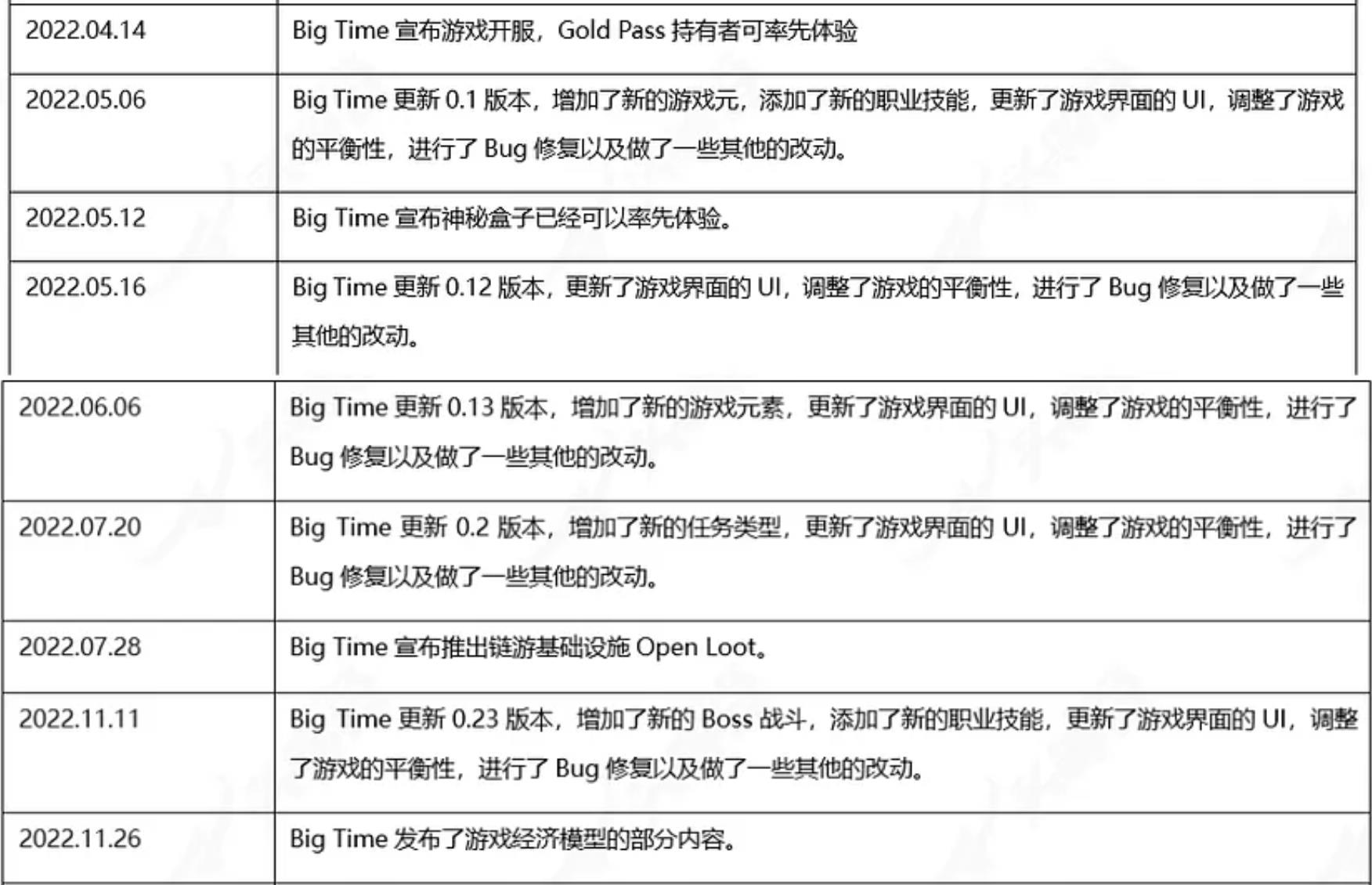
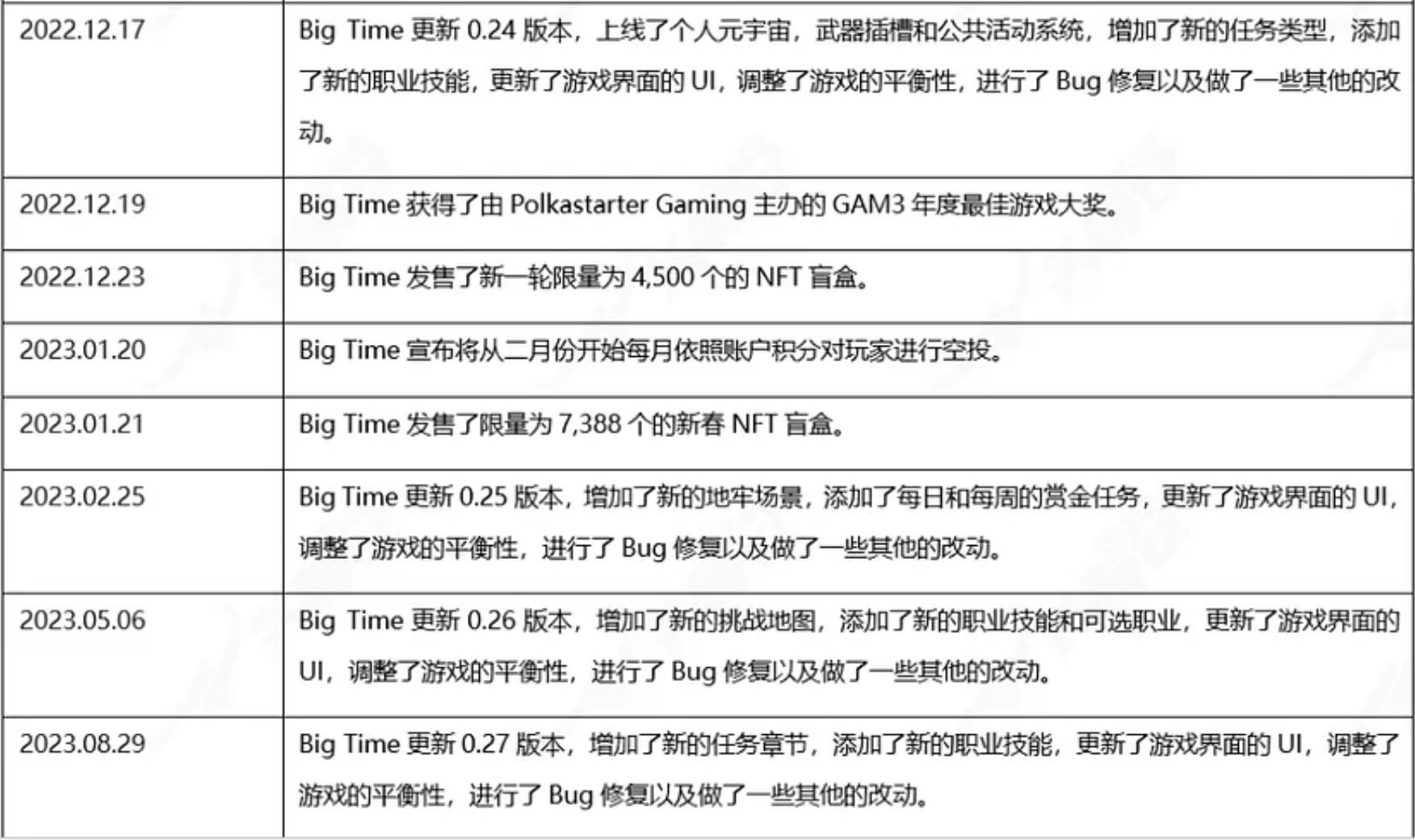
Table 3–1 Big Time Major Events
3.2 Current Status
Currently, Big Time is still in the beta testing phase. As of September 1, 2023, the game has been in beta testing for over a year and has been updated to version 0.27, with several major versions tested. However, due to limited testing qualifications, the actual online player count for the game is relatively low, with most servers being relatively idle.
3.2.1 Social Media Scale

Table 3–2 Big Time Social Media Data
As of October 9, 2023, Big Time's social media platforms have a large number of followers and high interaction. The community engages frequently, with most content focusing on game mechanics. Game streaming data is good, with over 2,000 streamers broadcasting Big Time, totaling over 40,000 hours of streaming. It has surpassed Axie Infinity to become the most streamed Web3 game by streamers, and the total watch time has exceeded 480,000 hours. It is estimated that the core fan base of the game is currently over a thousand people, and it may continue to increase in the future.
### 3.3 Future
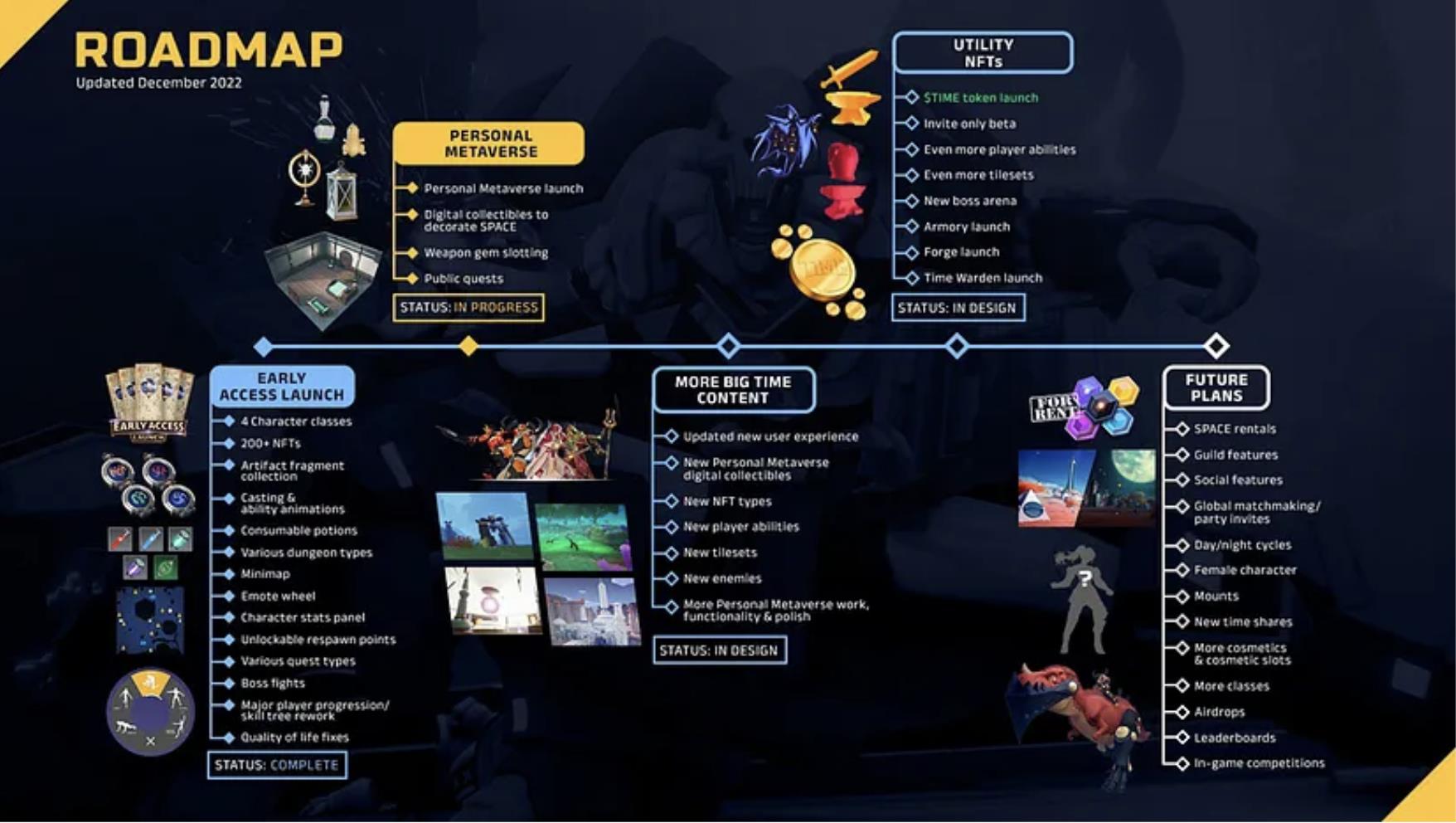
3.1 Big Time Roadmap [17]
Big Time is currently in the beta testing phase, and the development focus for the next few versions will be on the development of the BIGTIME token and the implementation of functional NFTs. In the future, Big Time will also update more main storyline content to enhance the game experience. On October 10, 2023, Big Time plans to launch the preseason version, expecting a large influx of new players into the game.
Summary:
From the perspective of project development, the game's current operation and development pace are slower than expected, but the game has already attracted a group of highly engaged core players. After the subsequent versions are opened with zero barriers, it is likely to attract more players.
4. Economic Model
Big Time is about to launch the in-game token $BIGTIME. We have covered the BIGTIME token and the game's economic mechanism in the product section (Chapter 2), so we will not elaborate on it here.
5. Track
5.1 Current State of the Track
After entering 2023, the overall performance of the blockchain gaming market can only be considered mediocre for those who have high expectations for this track. However, compared to the overall downturn in the blockchain market, the blockchain gaming market is still performing well and still has significant development potential in the future.
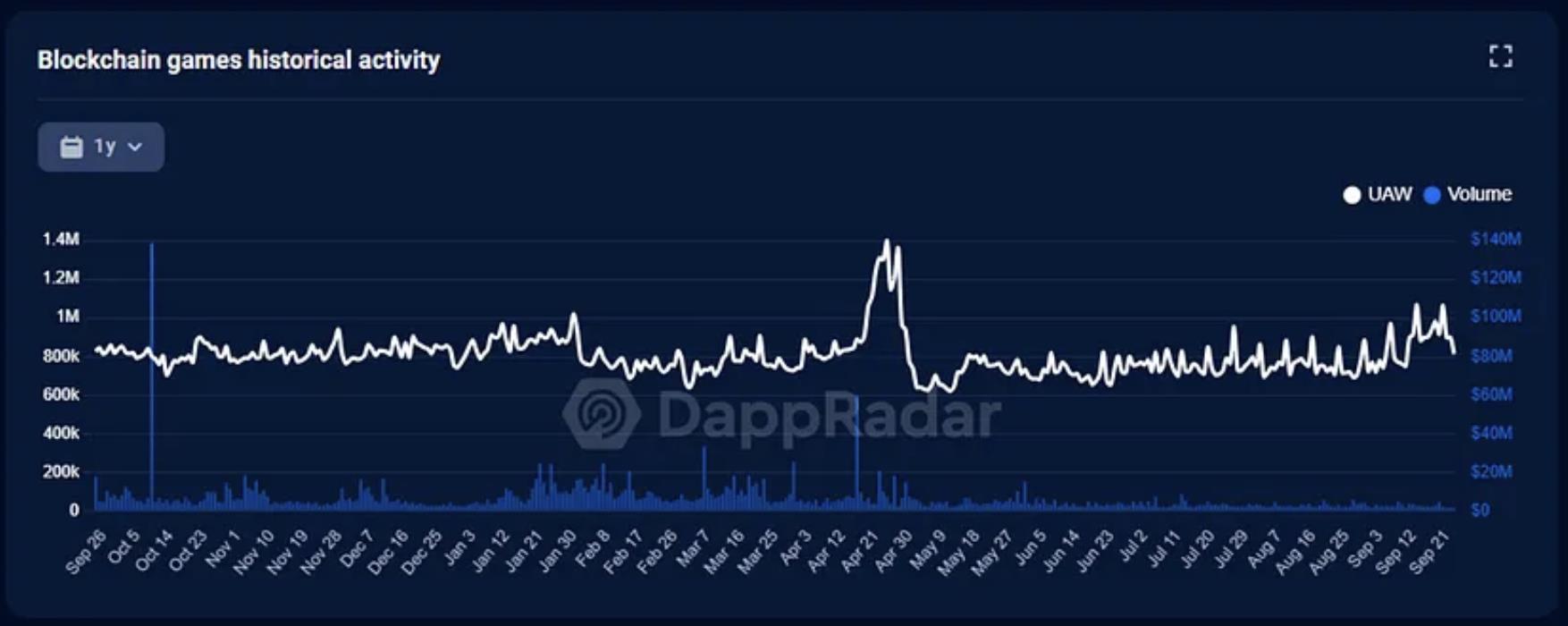
Figure 5–1 The only active wallet (UAW) and transaction volume in the blockchain gaming track [18]

Figure 5–2 The only number of users in the blockchain gaming track [19]
According to data from DappRader and Footprint, as of September 25, 2023, the number of the only active wallets (UAW) in the blockchain gaming track has remained at around 800,000 over the past year. Although it has decreased by over 30% compared to the average of around 1.2 million daily active wallets at the time of the first Big Time research report, overall, there has been no significant loss of core players in the blockchain gaming track. Once the overall market rebounds, the blockchain gaming market will have a foundation for recovery.
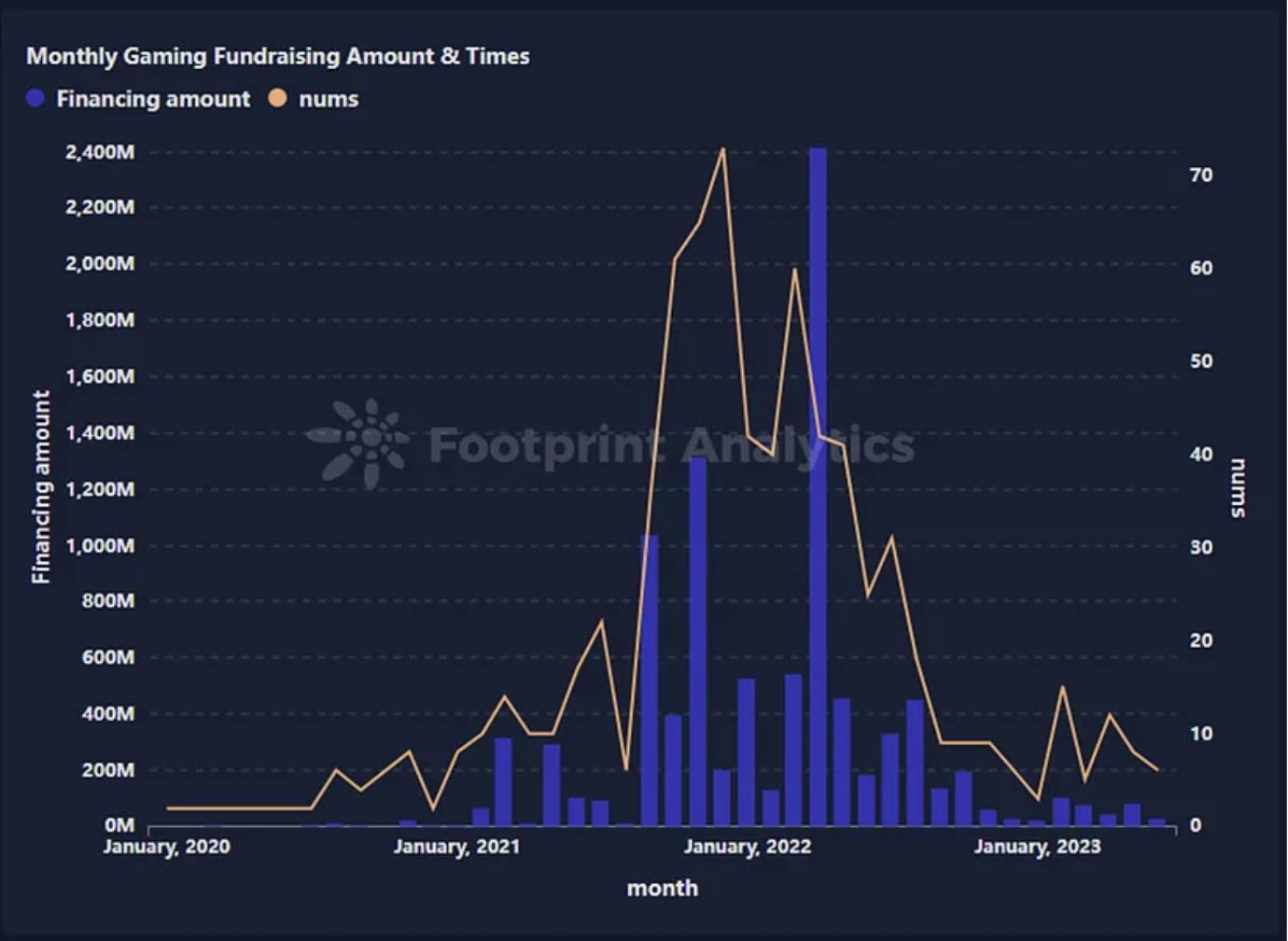
Figure 5–3 Financing amount and financing volume in the blockchain gaming track

Figure 5–4 Active number of blockchain games
Although the financing amount in the blockchain gaming track has decreased significantly over the past year, we can see that the active number of blockchain games has not shown a significant decrease, and is even slowly increasing. This indicates that the entire track is still maintaining growth and development, and has a certain resilience in the bear market.
Overall, both from the perspective of game data and player data, the blockchain gaming track is performing well in the current bear market environment.
5.2 Future of the Track
After the first wave of blockchain gaming led by StepN and Axie Infinity, the current blockchain gaming track has entered a somewhat contradictory environment. On one hand, the market has affirmed the feasibility of the entire blockchain gaming track, but on the other hand, the market is waiting for the emergence of the next paradigm to guide the track to the next stage.
Currently, many games are exploring various sub-tracks within the blockchain gaming track. The classification of the blockchain gaming track can be done in many ways, such as by asset category (full-chain games and partially core asset-chain games), by operation mode (Web2.5 games and Web3 games), and by gameplay mechanism (MOBA, FPS, MMORPG, etc.).
At present, among the mainstream classifications, we believe that partially core asset-chain Web2.5 games have great development potential. The reasons for this are as follows:
1) Limited on-chain performance and reliability have made it difficult for full-chain games to meet the interaction needs of most players in the game. Only chaining core assets can also reduce the operating costs for game operators.
2) Due to the high operational and product iteration requirements for most games, Web2.5 games operated in a Web2 manner but with Web3 features can achieve a balance between game operation efficiency and cost, ensuring that players have a basic gaming experience.
3) After the end of the first wave of blockchain gaming, the track has seen significant development, with increased investment in game development and player expectations for the next blockchain gaming paradigm. Therefore, old blockchain games that are close to mini-games or browser games in terms of mechanics and graphics are unlikely to achieve unexpected success. Players and the market are expecting a blockchain game masterpiece that can truly rival mainstream Web2 games.
Based on these points, we are relatively optimistic about games like Big Time, which are rooted in Web2 games and have sufficient development capabilities and experience. In addition, MMORPGs, as a game genre, often have a more stable user base and longer game lifespan compared to other types of games. While this means higher operational requirements for the project team, it also indicates greater development potential.
Summary
From the perspective of the track, despite a certain degree of decline in the number of blockchain gaming players and transaction volume since the bear market, the core group of blockchain gaming players still maintains high stickiness, and the overall progress of the track has not been significantly affected. Many new games are still being developed and operated. Once the overall macro environment improves, the blockchain gaming track still has potential. Based on the different types and development stages of the blockchain gaming track, we believe that games like Big Time, which partially chain core assets and are rooted in Web2 games, and have sufficient development capabilities and operational experience, will have greater development potential in the future.
6. Risks
1) Game Economic Model
The tokens in Big Time can only be obtained through normal gameplay, which often requires players to have a high level of game participation.
2) Team Risk
The game rules are customized by the team, and the team may change/adjust the game rules at any time based on the current state of the game, potentially causing harm to player interests.
3) Game Bug Risk
There are still a large number of game bugs in the current game version, some of which may be malicious bugs affecting game assets. Players need to be cautious and provide immediate feedback to the project team.
免责声明:本文章仅代表作者个人观点,不代表本平台的立场和观点。本文章仅供信息分享,不构成对任何人的任何投资建议。用户与作者之间的任何争议,与本平台无关。如网页中刊载的文章或图片涉及侵权,请提供相关的权利证明和身份证明发送邮件到support@aicoin.com,本平台相关工作人员将会进行核查。





